
Article Summary: Texas Landmarks
Texas Landmarks. More Than Just Parks has 25 incredible must-see sites for you to visit.
There’s so much more to this exciting place than the Dallas Cowboys. In this article, we’ll familiarize you with the incredible landmarks located in the Lone Star State.
We’ve got incredible places, iconic memorials, fascinating museums, epic monuments and so much more.
We’re going to give you our list of the Top 25 Landmarks In Texas.
So, What Is A Landmark?
Well, it’s a place of “a special character or special historical or aesthetic interest or value as part of the development, heritage, or cultural characteristics of a city, state, or nation.”
Why visit these places? Because landmarks connect us to the past. Through visiting these wonderful places where history occurred we find our roots. It allows us to feel like we are a part of something much bigger than ourselves.
And, speaking of history, did I mention that I taught the subject? I spent a lifetime teaching about the history behind many of these momentous sites. Then I got to see them firsthand. And now I’m sharing the stories of these incredible places with you. It doesn’t get any better than that!
So, without further ado, let’s dive in.
Texas Landmarks
Some Fascinating Facts About Texas
- Texas is the second largest state in the United States, both by land area and population. Only Alaska is larger in size.
- The state’s nickname is the “Lone Star State,” referring to the single star on its flag, which symbolizes Texas’ struggle for independence from Mexico.
- Texas was an independent republic from 1836 until it joined the United States in 1845.
- The state capital of Texas is Austin, but its largest city is Houston.
- Texas is home to two of the largest cities in the United States, Houston and Dallas.
- The state’s economy is one of the largest in the world, with industries ranging from oil and gas to technology to agriculture.
- The famous Alamo, a key site in the Texas Revolution, is located in San Antonio.
- Texas is known for its Tex-Mex cuisine, which combines traditional Mexican food with Texan flavors and ingredients.
- The state’s official flower is the bluebonnet, and its state bird is the mockingbird.
- Texas is the birthplace of several notable people, including former President Lyndon B. Johnson, musician Beyoncé, and football player Earl Campbell.

We’re Excited To Share Our List Of The Top 25 Texas Landmarks With YOU
Bold, big, and distinctive, the friendliness of its people, the vibrancy of its art scenes, the distinctiveness of its cowboy culture, and the richness of its diversity make Texas a one-of-a-kind place to live and work.
It’s also a great place to explore some amazing landmarks. More Than Just Parks is excited to share our list of the Top 25 Texas Landmarks with you. And we’re kicking off our list at #25 with Port Isabel Lighthouse.

Top 25 Texas Landmarks
25. Port Isabel Lighthouse
Port Isabel Lighthouse is located in Port Isabel, Texas. It was built in 1852 to guide ships through the Brazos Santiago Pass to the port of Matamoros, Mexico, and is now a museum operated by the Texas Parks and Wildlife Department.
The construction of the lighthouse was authorized by the US Congress in 1850 and was completed in 1852 at a cost of $10,000. The lighthouse was built on a 50-foot bluff overlooking the Gulf of Mexico, and its light could be seen for 16 miles out to sea. The light was originally fueled by whale oil, but it was later converted to kerosene and then electricity.

Point Isabel, Texas / from a sketch by our special artist, C.E.H. Bonwill | Courtesy of Wikimedia Commons
The Port Isabel Lighthouse During The Civil War
During the Civil War, Confederate forces occupied the lighthouse and used it as a lookout post. In 1864, Union forces attacked and captured the lighthouse, which they used as a signal station until the end of the war.
After the Civil War, the lighthouse was returned to the federal government and resumed its function as a navigational aid. In 1927, it was decommissioned and replaced by a modern beacon.
The lighthouse was then sold to the city of Port Isabel, which used it as a water tower until the 1930s.
In 1950, the lighthouse was acquired by the state of Texas and was restored to its original condition. It was opened to the public as a museum in 1952, the centennial of its construction.
Today, the Port Isabel Lighthouse is a popular tourist attraction and a symbol of the city’s maritime history. Visitors can climb the 75 steps to the top of the lighthouse for panoramic views of the surrounding area and the Gulf of Mexico.
The museum also features exhibits on the history of the lighthouse and the maritime history of the region.

24. Galveston East End Historic District
Our next Texas landmark features architecture with a variety of styles and periods, including Greek Revival style homes built in the 1850s. At #24 on our list of the Best Texas Landmarks is the Galveston East End Historic District.
The Galveston East End Historic District is listed on the National Register of Historic Places. The district encompasses an area of approximately 50 blocks on the eastern end of Galveston Island, and features a diverse collection of historic architecture and urban design.
The district’s history dates back to the late 19th century when Galveston was one of the wealthiest and most important cities in the southern United States. The district was developed as a residential neighborhood for the city’s elite, who built grand mansions and ornate homes along tree-lined streets.
Many of these homes were designed by prominent architects of the day, including Nicholas J. Clayton and Alfred Muller.
However, in 1900, the district was hit by the devastating Galveston Hurricane, which destroyed many of the district’s homes and caused widespread damage throughout the city. In the aftermath of the storm, the district was rebuilt with a mixture of new construction and renovations to the surviving historic homes.
Galveston East End Historic District In The 20th Century
Throughout the early 20th century, the East End continued to thrive as a residential and commercial hub, with new businesses and institutions such as the University of Texas Medical Branch (UTMB) and the Galveston College of Medicine opening in the area.
However, in the mid-20th century, the district began to decline as many of its residents moved to newer suburbs on the mainland and the area became more economically depressed.
In the 1970s and 1980s, the East End began to undergo a renaissance as new residents and developers began to restore many of the district’s historic homes and buildings.
Today, the district is once again a thriving and diverse community, with a mix of residential, commercial, and institutional uses. The district’s historic architecture and urban design continue to be a major draw for tourists and visitors to Galveston Island, and the area is considered one of the most significant historic districts in the state of Texas.

23. Fort Worth Stockyards
Our next Texas landmark hosts the world’s only twice-daily cattle drive. All this – plus more than a hundred new shopping, dining and entertainment venues – makes it one of Texas’ most popular tourist destinations.
At #23 on our list of the Best Texas Landmarks is the Fort Worth Stockyards.
The Fort Worth Stockyards was a hub for the livestock industry in Texas and the surrounding areas and was once one of the largest livestock markets in the world.
The history of the Fort Worth Stockyards can be traced back to the arrival of the Texas and Pacific Railway in 1876. The railroad brought with it a new era of transportation and made it possible for ranchers and farmers to transport their livestock to markets beyond their local areas.
In 1890, the Fort Worth Stockyards Company was formed, and the first cattle were sold in the newly built yards that same year. Over the next few decades, the stockyards grew and became a major center for the cattle industry, with as many as 160,000 cattle being sold in a single week during the peak of the industry.
The Stockyards Played A Critical Role In The Development Of Fort Worth
The stockyards played a critical role in the development of Fort Worth as a major economic and cultural center. Cowboys, cattle drivers, and other workers came to the city to sell and trade their livestock, and the stockyards became a place for social gatherings, celebrations, and entertainment.
The stockyards also played a role in the development of the American cowboy culture. Cowboys would come to the stockyards to purchase their gear, and the local shops and stores began catering to this unique clientele. The stockyards were also the site of many famous cattle drives, including the Chisholm Trail, which brought cattle from Texas to Kansas.
In the mid-20th century, the Fort Worth Stockyards began to decline as the cattle industry shifted to other parts of the country. However, the district was saved from demolition by a group of investors and was designated a National Historic District in 1976.
Today, the Fort Worth Stockyards is a popular tourist attraction and a symbol of Texas history and culture. The district features a variety of restaurants, shops, and entertainment venues, as well as daily cattle drives and other cowboy-themed events.
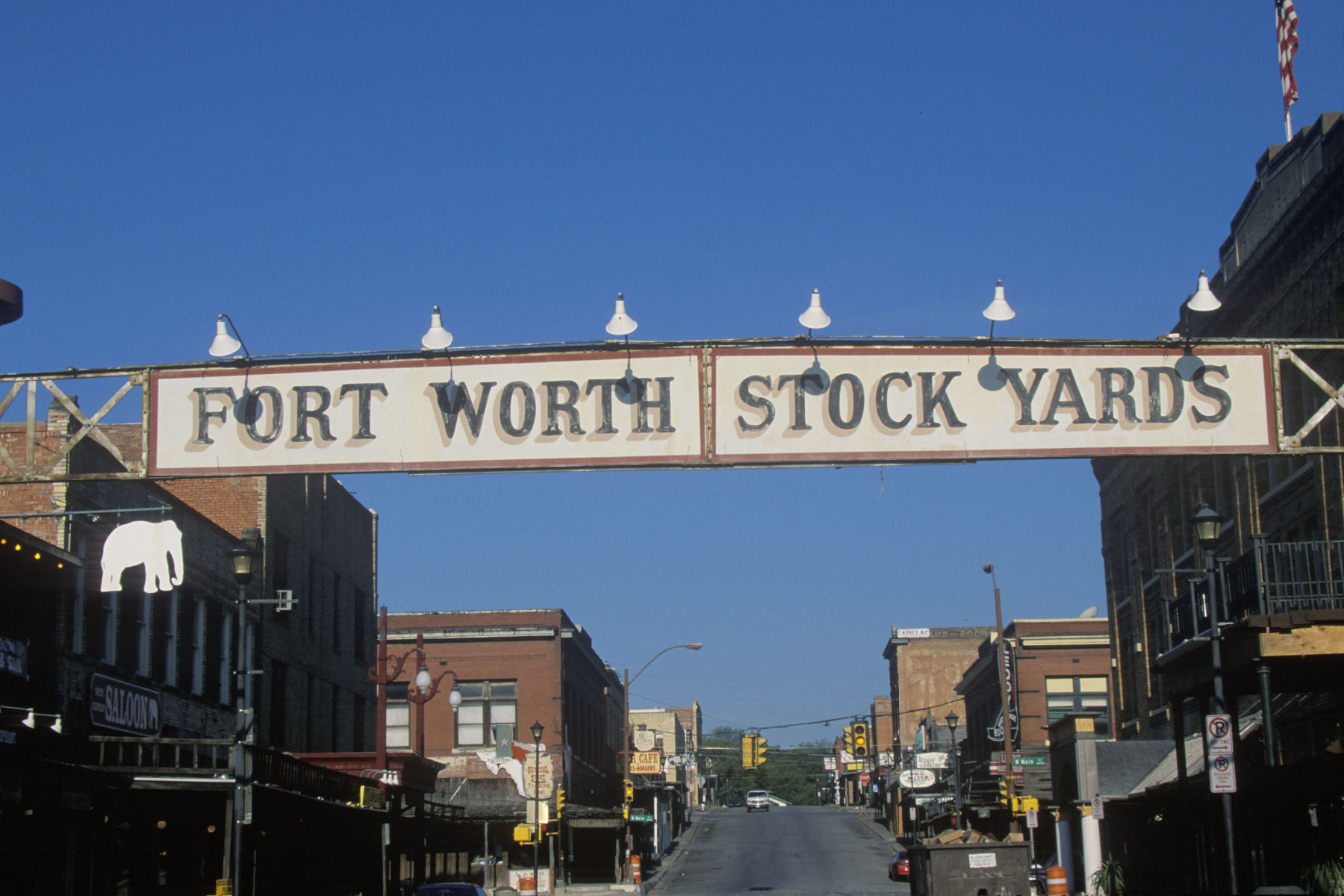
22. Cadillac Ranch
Our next Texas Landmark is a public art installation and sculpture on Route 66, just west of Amarillo, Texas. The site features ten half-buried Cadillacs, nose-first in the ground that are colorfully sprayed with graffiti today.
At #22 on our list of the Best Texas Landmarks is Cadillac Ranch.
Cadillac Ranch is a public art installation located in Amarillo, Texas, that features ten Cadillac cars buried nose-first in the ground. The history of Cadillac Ranch dates back to 1974, when it was created by a group of artists known as the Ant Farm.
The Ant Farm was a collective of artists and architects who sought to create new and innovative forms of art. In the early 1970s, they were approached by Amarillo millionaire Stanley Marsh with a proposal to create a unique roadside attraction.
Marsh provided the funding for the project and gave the Ant Farm permission to use his land just outside Amarillo. The artists then set about creating Cadillac Ranch, a monumental work of art that was designed to celebrate America’s love affair with the automobile.

The Cars Were Purchased From Local Junkyards
To create the installation, the Ant Farm used ten used Cadillac cars that were purchased from local junkyards. The cars were then buried nose-first in the ground, with their tail fins sticking up in the air.
The placement of the cars was carefully calculated to create an aesthetically pleasing composition. The cars were also aligned with the angles of the Great Pyramid of Giza, a design feature that added to the mystique and symbolism of the installation.
Cadillac Ranch quickly became a popular attraction for locals and tourists alike. It was featured in numerous movies, TV shows, and music videos, and has become a cultural icon of American art.
Over the years, Cadillac Ranch has undergone numerous renovations and restorations. In the late 1990s, the Ant Farm’s original cars were removed and replaced with ten newer Cadillacs.
Today, visitors are encouraged to bring spray paint and add their own graffiti to the cars, making the installation a constantly evolving work of art.
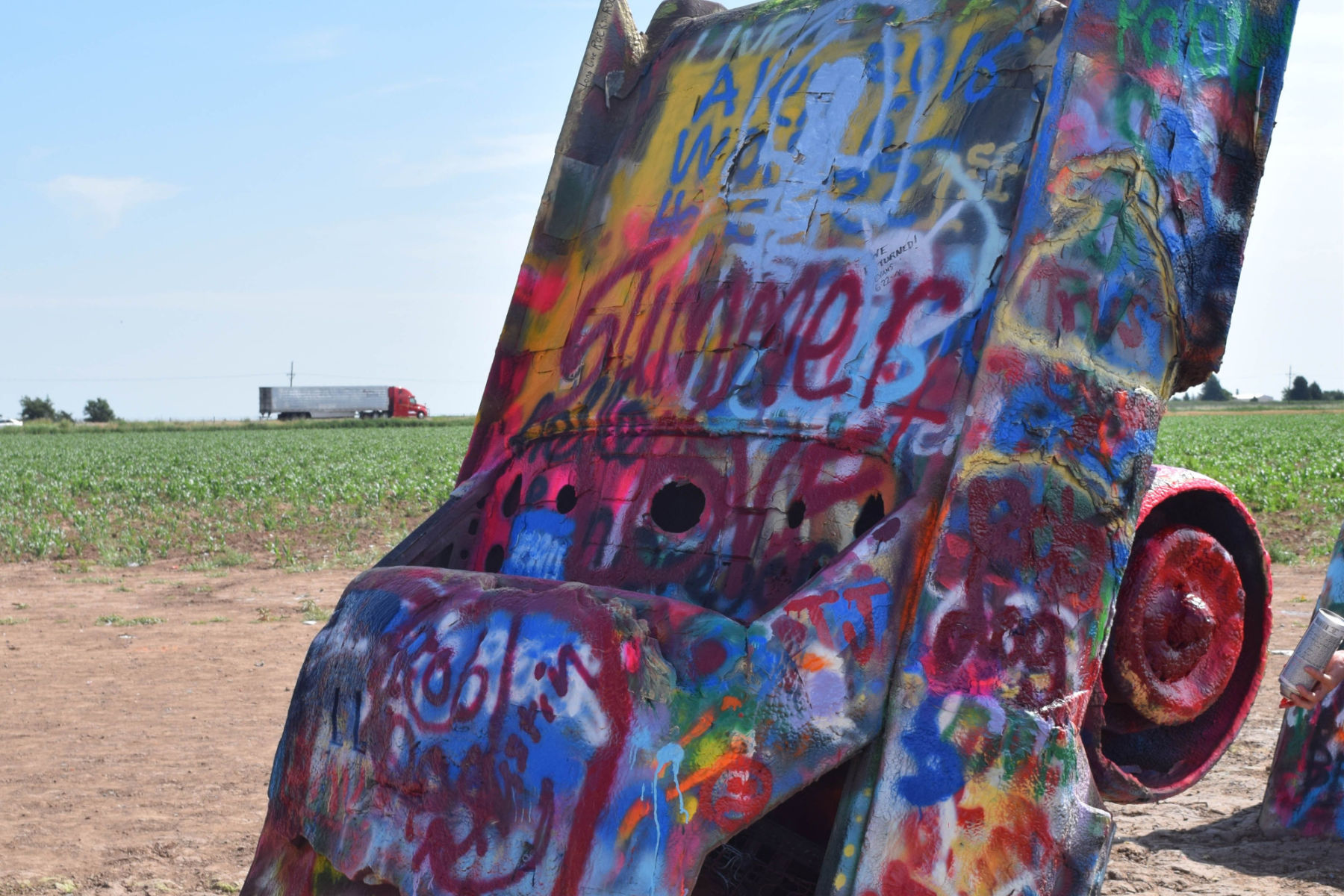
21. Reunion Tower
If you love a great view then our next Texas landmark is for you. From 470 feet up you’ll experience breathtaking 360-degree panoramic views, a free digital photo and an indoor/outdoor observation deck that lets you see for miles in any direction.
At #21 on our list of the Best Texas Landmarks is Reunion Tower.
Reunion Tower is an iconic observation tower located in downtown Dallas, Texas. It is a 561-foot-tall structure with a distinctive geodesic dome at the top, which houses an observation deck, restaurant, and event space.
The tower was completed in 1978 as part of a downtown redevelopment project known as the “Reunion” project, which aimed to revitalize the area around Union Station and the historic Reunion Arena. The tower was designed by architectural firm Welton Becket and Associates, and its unique shape and design quickly became a symbol of Dallas.
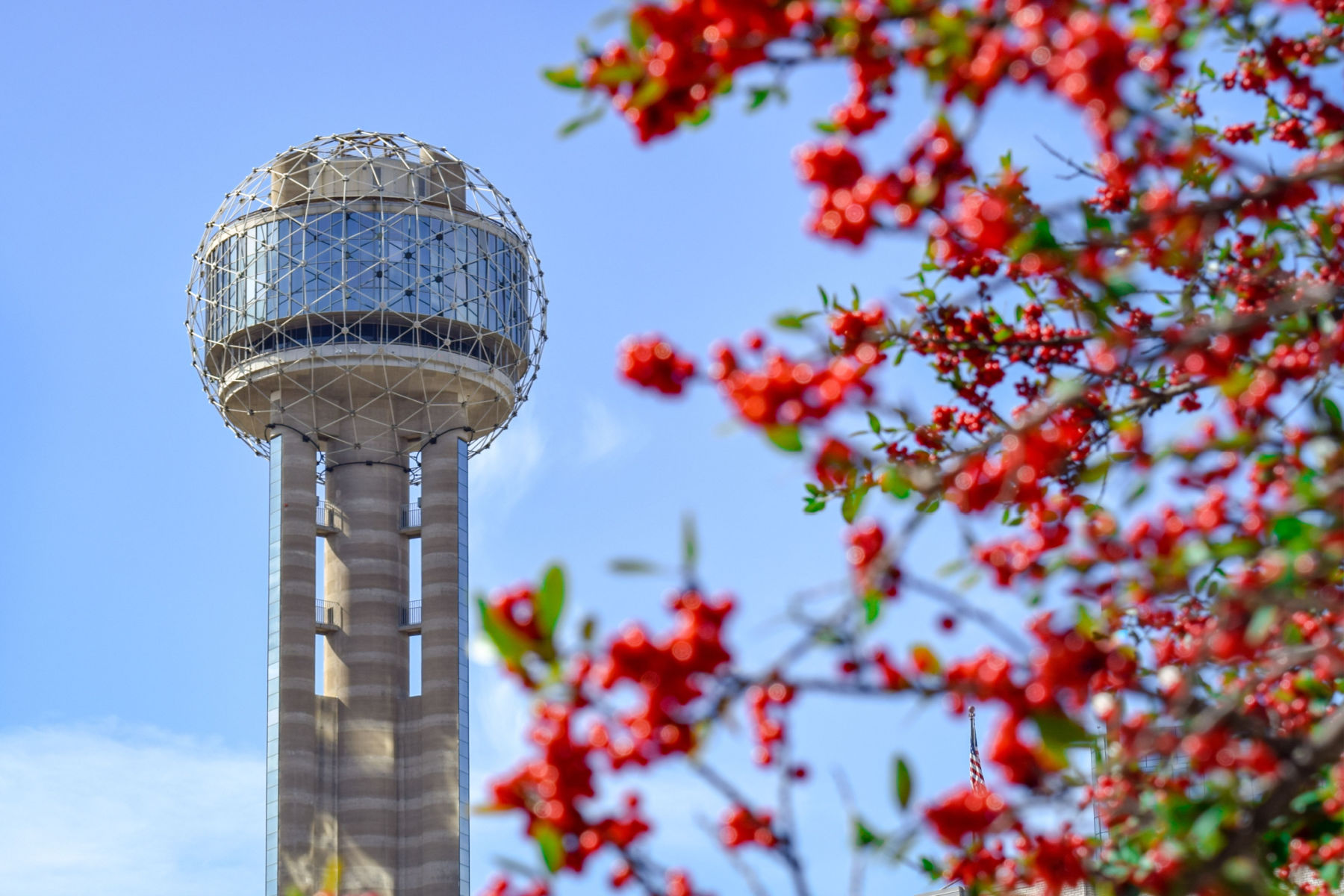
Check Out The GeO-Deck
The observation deck at the top of the tower, known as the GeO-Deck, offers 360-degree views of the Dallas skyline and surrounding areas. Visitors can access the observation deck via high-speed elevators, which take them to the top of the tower in just 68 seconds.
The GeO-Deck also features interactive exhibits and displays that highlight the history and culture of Dallas.
The restaurant at the top of the tower, called Five Sixty by Wolfgang Puck, is a fine dining establishment that offers panoramic views of the city. The restaurant revolves 360 degrees every hour, giving diners a constantly changing view of the city as they enjoy their meals.
In addition to the observation deck and restaurant, Reunion Tower also offers event spaces for private parties, corporate events, and weddings. The tower’s ballroom and other event spaces offer stunning views of the city and are a popular destination for special events.
Reunion Tower is a popular tourist destination in Dallas and a beloved landmark of the city’s skyline. It has been featured in numerous films and television shows, including the opening credits of the television series “Dallas.”
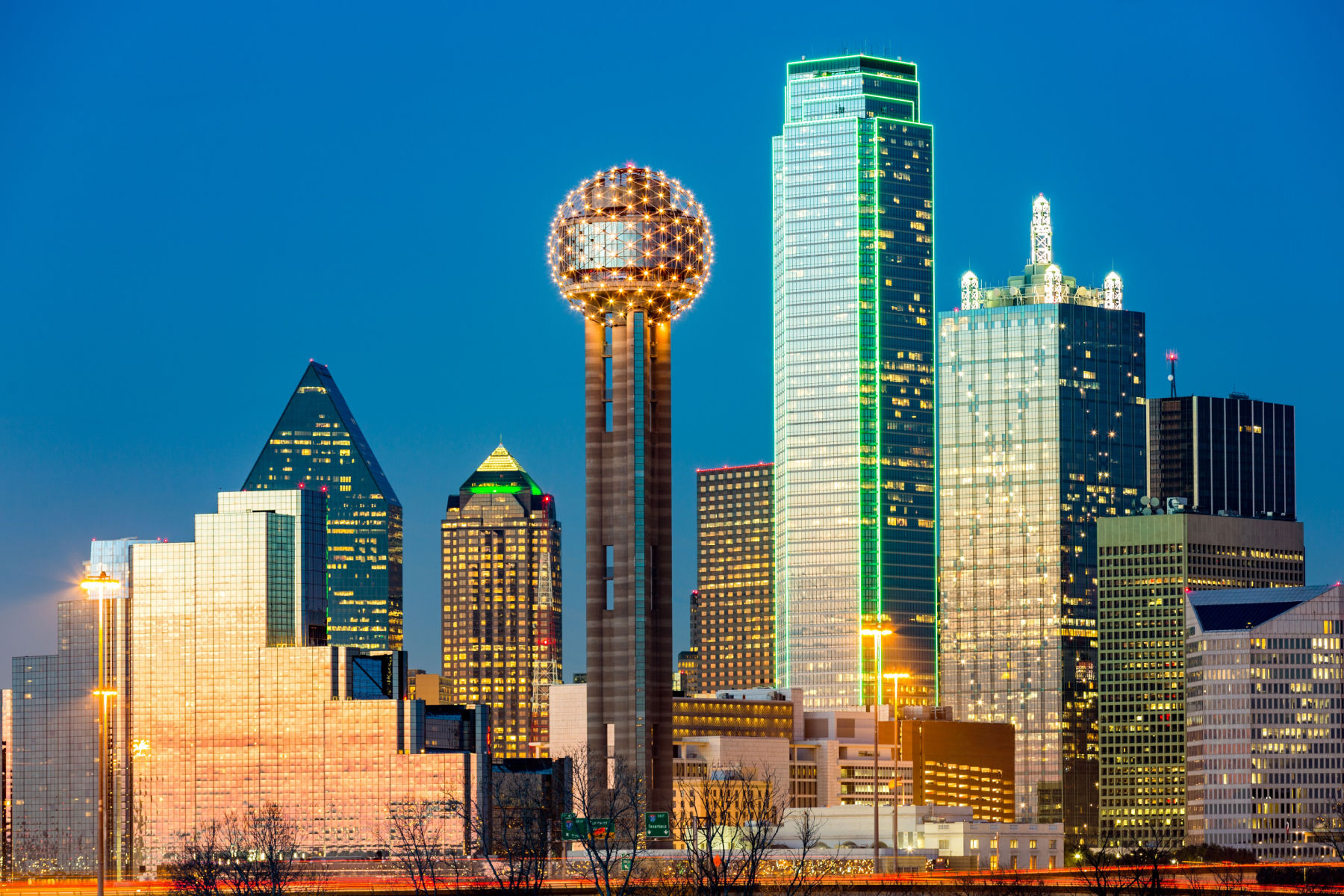
Top 20 Texas Landmarks
20. Pioneer Village
We’re on to the Top 20 Texas landmarks. At #15 on our list of the Best Texas Landmarks is a a replica village of 10 historic structures – including an 1892 Greek Revival house museum, blacksmith shop and broom factory, 1830s and 1840s log homes, smokehouse and the 1870s Hamon Church.
Welcome to Pioneer Village.
Pioneer Village is a historic site and living history museum located in Gonzales, Texas. The museum is dedicated to preserving and interpreting the history of the region, with a particular focus on the pioneer era of the mid-19th century.
The village consists of a collection of historic buildings and artifacts, including a blacksmith shop, a one-room schoolhouse, a log cabin, a general store, and a variety of farm implements and tools.
The buildings and artifacts have been collected and preserved over the years by the Gonzales County Historical Commission, which oversees the museum.
Visitors to Pioneer Village can explore the buildings and artifacts on their own or take guided tours led by knowledgeable volunteers. The museum also offers a variety of educational programs and events, including living history demonstrations, crafts workshops, and lectures on various aspects of pioneer life.
In addition to its historical significance, Pioneer Village is an important cultural institution in Gonzales and a popular destination for visitors and locals alike. It offers a unique opportunity to experience the history of the region and to learn about the challenges and triumphs of the pioneer era.
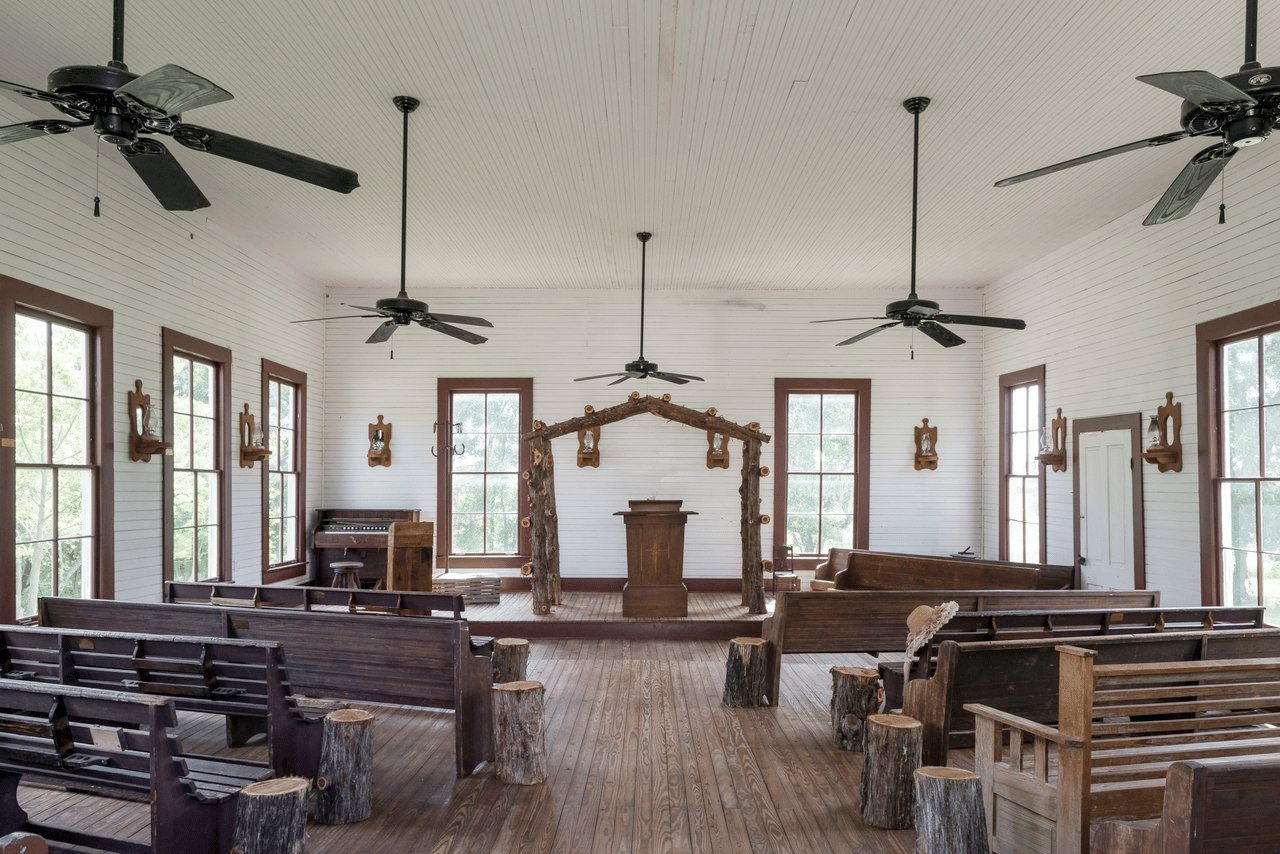
19. Deep Ellum Historic District
Our next Texas landmark was one of the city’s first commercial districts to welcome African Americans and European immigrants, and it soon became a center for industry. At #19 on our list of the Best Texas Landmarks is Deep Ellum.
It’s a vibrant neighborhood located in Dallas, Texas. The district is known for its rich history, cultural diversity, and thriving arts and entertainment scene.
The neighborhood was founded in the late 19th century as a center for industry and commerce, and it quickly became a hub for African American and immigrant communities.
In the early 20th century, Deep Ellum emerged as a center for jazz and blues music, and it was home to some of the most famous performers of the era, including Blind Lemon Jefferson and Robert Johnson.
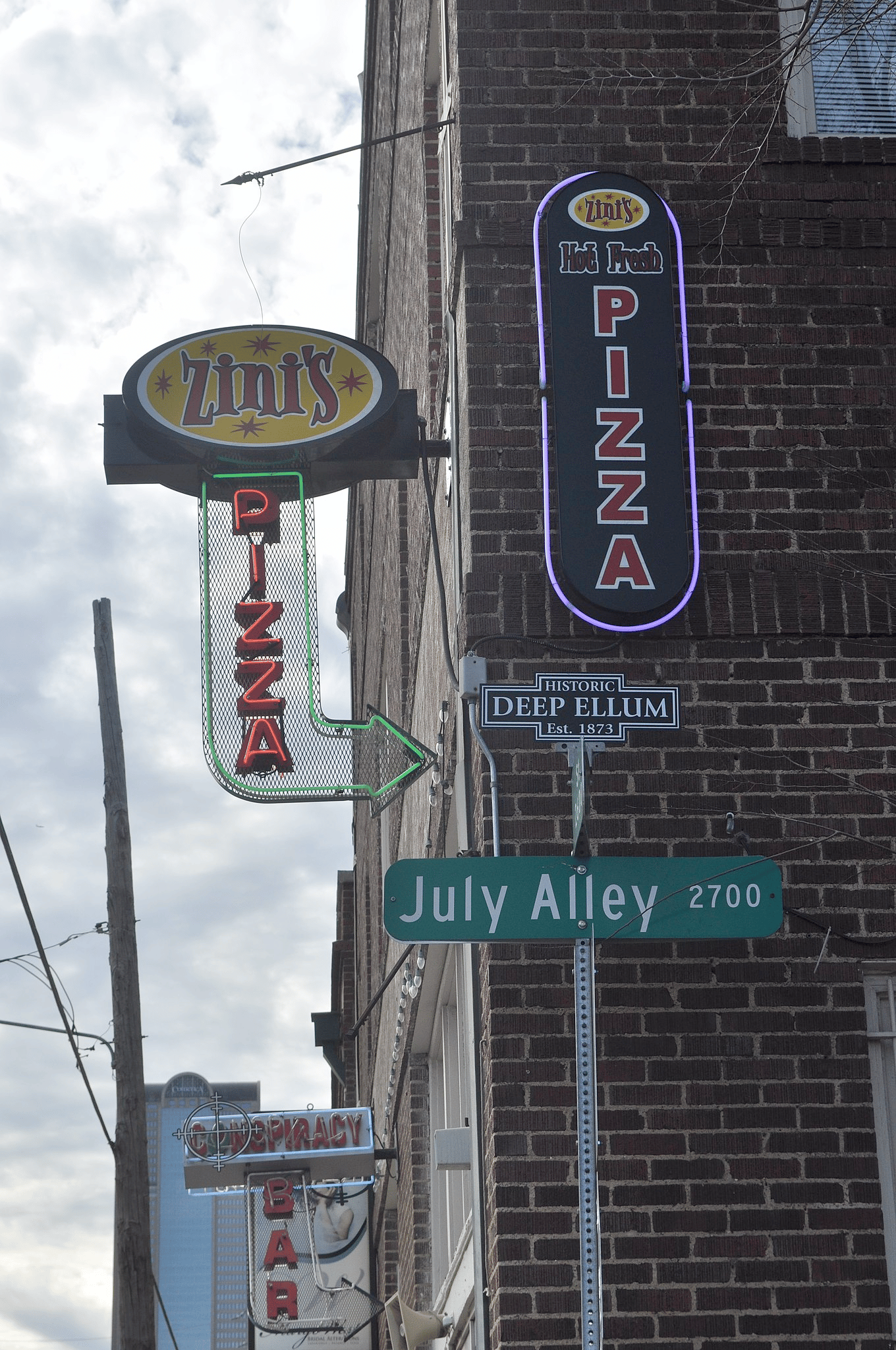
It’s Been A Music Hotspot
It was in the 1920s that Deep Ellum started to become a destination for music, specifically jazz and the blues.
Within the course of a few decades, the neighborhood hosted artists like Huddie “Leadbelly” Ledbetter, Bessie Smith, Texas Bill Day, Blind Lemon Jefferson, Robert Johnson and many more.
In 1933, a song titled “Deep Elm Blues” was recorded by the Lone Star Cowboys and, later, the Shelton Brothers; years later, it would even be covered by The Grateful Dead. Altogether, from 1920 to 1950, the number of nightclubs, cafes and domino parlors in Deep Ellum jumped from 12 to 20.
However, just as the Deep Ellum music scene began to reach its peak, changes in American life temporarily dampened it. As people began moving from the city to the suburbs and the growing popularity of the automobile brought encroaching highways into the neighborhood, businesses were forced to close.
It wasn’t until 1980 that Deep Ellum saw a massive rebirth in thanks to the Dallas punk scene, which helped launched the careers of musicians like Tripping Daisy and the New Bohemians. Ten years later, the music venue Trees would open its doors and begin to host nationally acclaimed acts like Nirvana, the Roots, Radiohead and more. (Source: Parks For Downtown Dallas)
Deep Ellum Has Continued To Evolve & Change
In the decades that followed, Deep Ellum continued to evolve and change, with waves of new immigrants and artists contributing to the neighborhood’s rich cultural heritage.
Today, Deep Ellum is a thriving arts and entertainment district, with a diverse mix of galleries, music venues, restaurants, and shops.
Visitors to Deep Ellum can explore the neighborhood’s many cultural offerings, including art exhibits, live music performances, and food festivals. The district also offers a variety of historical and architectural landmarks, including the historic Kirby Building, the Deep Ellum Station, and the old Union Bankers Trust Building.
In addition to its cultural and historical significance, Deep Ellum is an important center of community and activism in Dallas. The neighborhood has a strong sense of identity and pride, and it is a hub for grassroots organizations, social justice movements, and community-based initiatives.
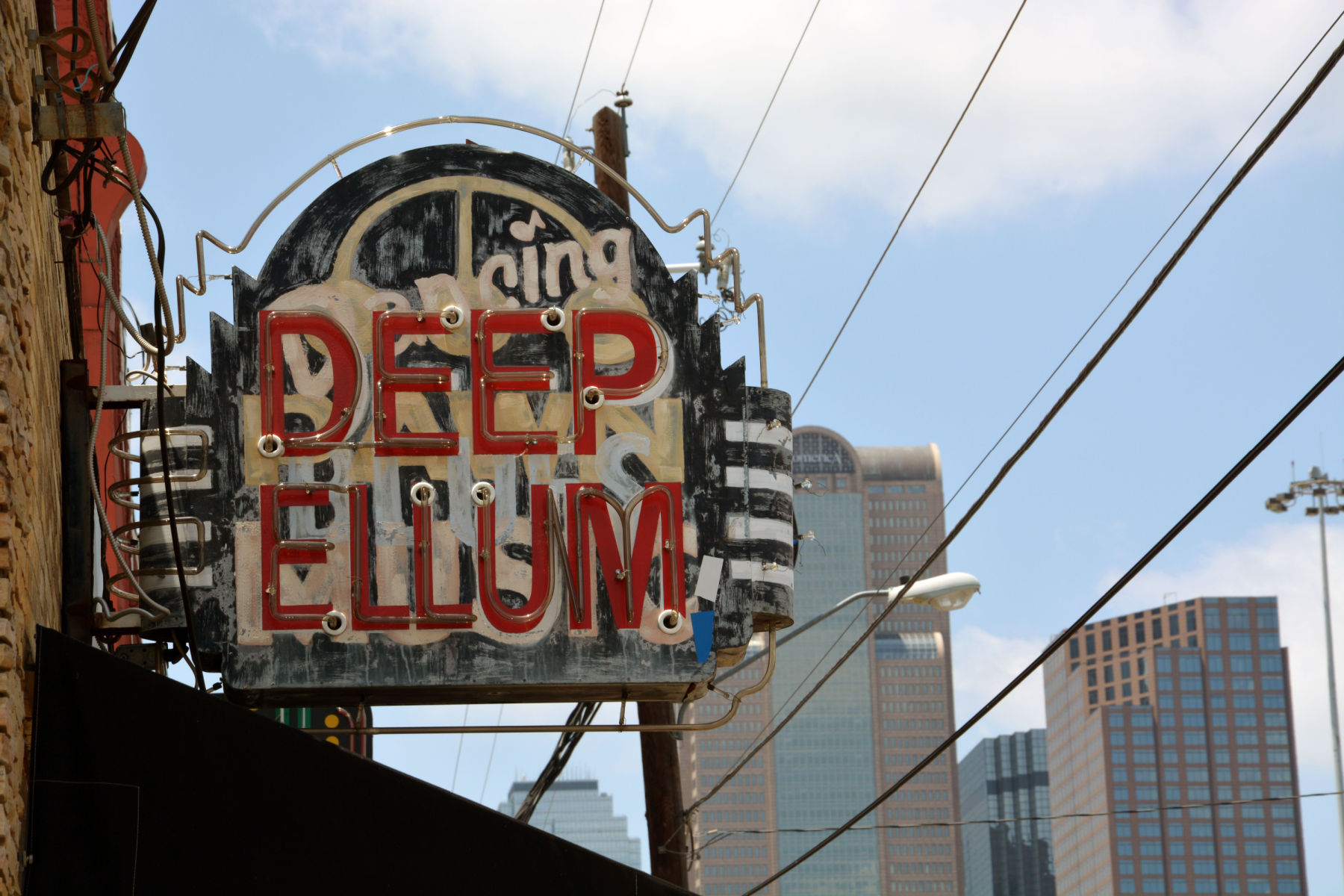
18. Washington-on-the-Brazos State Historic Site In Texas
We move from a place which is the embodiment of the Texas entertainment scene to one which celebrates the state’s rich history. At #18 on our list of the Best Texas Landmarks is Washington-on-the-Brazos State Historic Site.
The Washington-on-the-Brazos State Historic Site is located near the town of Washington, Texas. The park is dedicated to preserving and interpreting the history of Texas and the role of Washington in the state’s founding.
The site is located on the banks of the Brazos River, where a group of 59 delegates met in 1836 to sign the Texas Declaration of Independence from Mexico.
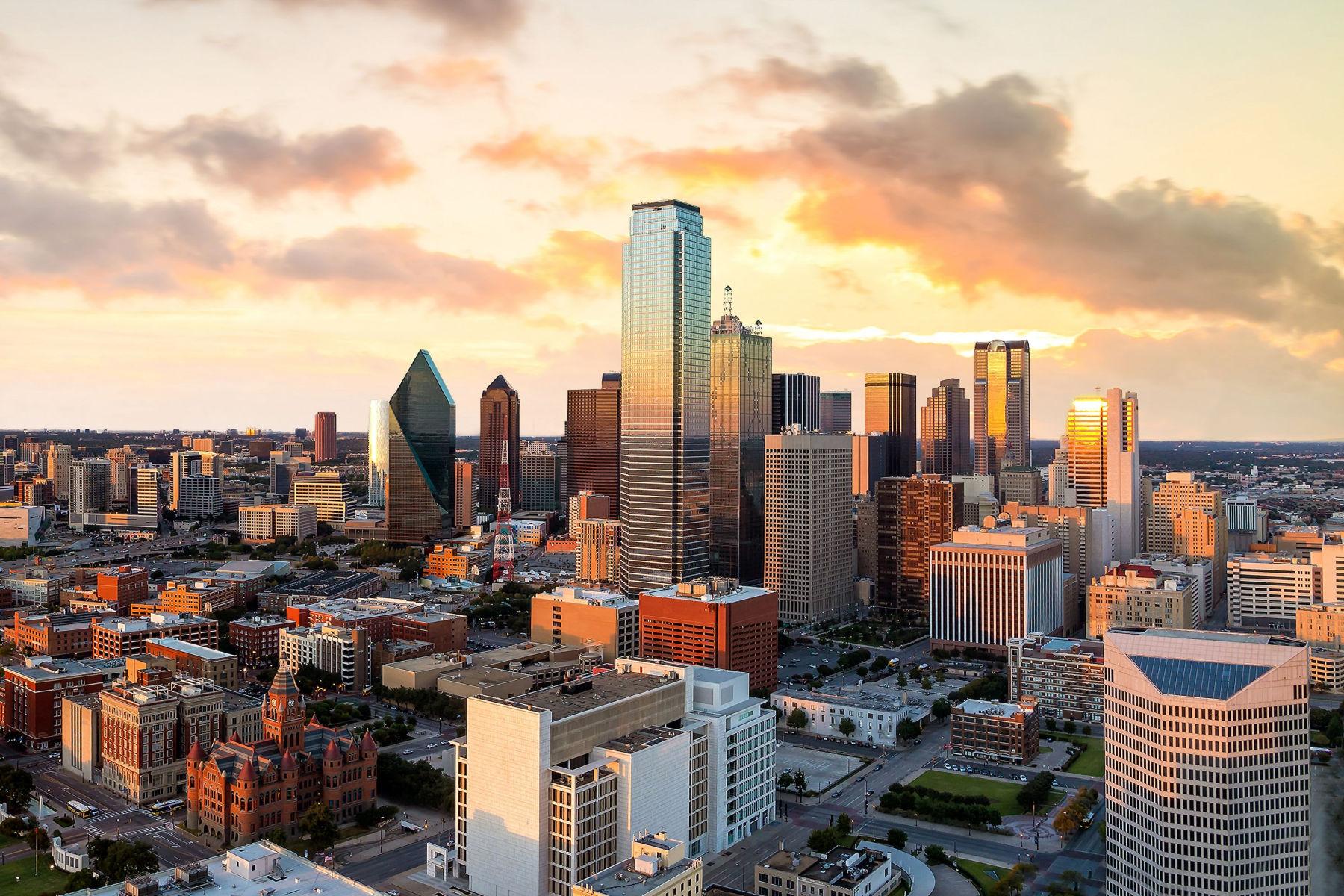
The Site Features Buildings & Structures That Have Been Restored To Their Original Appearance
The historic site includes several buildings and structures that have been restored to their 19th-century appearance, including Independence Hall, which served as the site of the signing of the Declaration of Independence.
Visitors to the Washington-on-the-Brazos State Historic Site can explore the various historical buildings and exhibits on their own or take guided tours led by knowledgeable staff. The site also offers a variety of educational programs and events, including living history demonstrations, historical reenactments, and lectures on various aspects of Texas history.
In addition to its historical significance, the Washington-on-the-Brazos State Historic Site is also an important recreational destination, offering opportunities for hiking, picnicking, and birdwatching.
The site includes several scenic overlooks and trails, as well as a replica of an 1830s-era farmstead that offers a glimpse into the daily life of early Texas settlers.
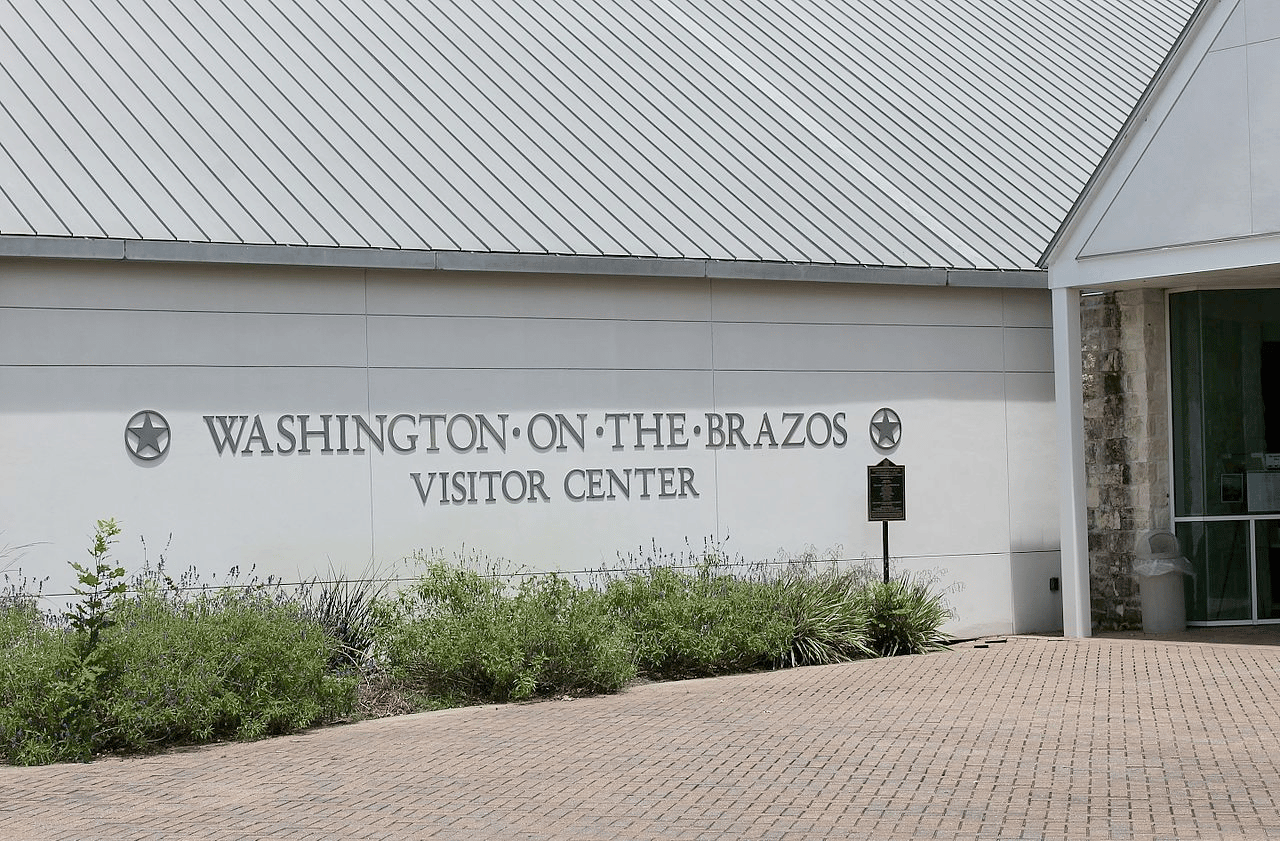
17. San Antonio River Walk
Our next Texas landmark is a world-renowned 15-mile urban waterway. The River Walk, or Paseo del Rio, is a San Antonio treasure and the largest urban ecosystem in the nation.
Tucked quietly below street level and only steps away from the Alamo, it provides a serene and pleasant way to navigate the city. And it’s #17 on our list of the Best Texas Landmarks.
The San Antonio River Walk is a network of walkways that run alongside the San Antonio River in downtown San Antonio, Texas. It is one of the city’s most popular tourist attractions, drawing millions of visitors each year.
The history of the River Walk dates back to the early 20th century, when a devastating flood in 1921 caused extensive damage to the downtown area. In the aftermath of the flood, local officials began exploring ways to mitigate the risk of future floods while also beautifying the city.
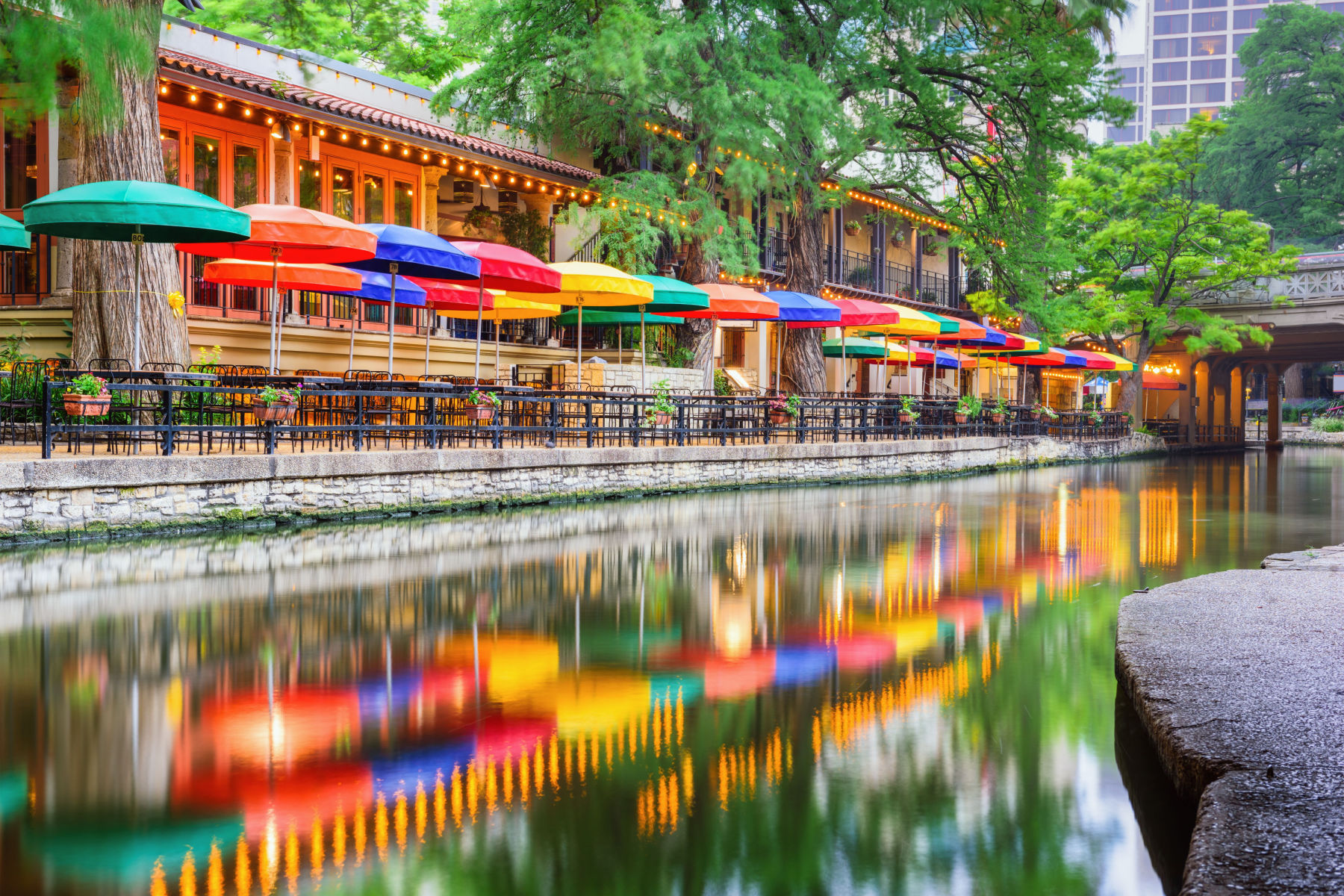
A Series Of Walkways & Bridges Connecting The City’s Downtown Area To The River
The idea of creating a network of walkways along the San Antonio River was first proposed in the 1920s, but it wasn’t until the 1930s that the project began to take shape. The River Walk was designed by architect Robert H.H. Hugman, who envisioned a series of walkways and bridges that would connect the city’s downtown area to the river.
Construction of the River Walk began in the 1930s, with funding from the Works Progress Administration (WPA) and other federal agencies. The first section of the River Walk was completed in 1941, and the project was completed in the 1950s.
Today, the River Walk stretches for miles along the San Antonio River, with a network of pedestrian walkways, bridges, and stairways that connect restaurants, shops, hotels, and other attractions. The River Walk is also home to a number of cultural institutions, including the Arneson River Theater and the San Antonio Museum of Art.
One of the most popular features of the River Walk is its network of colorful, ornate barges that take visitors on guided tours of the waterway. The River Walk is also known for its annual holiday festival, Fiesta de las Luminarias, during which the walkways are lined with thousands of illuminated lanterns.
The San Antonio River Walk is a vibrant and dynamic part of the city’s culture and history, and it continues to draw visitors from around the world to experience its unique blend of natural beauty, cultural attractions, and lively entertainment.
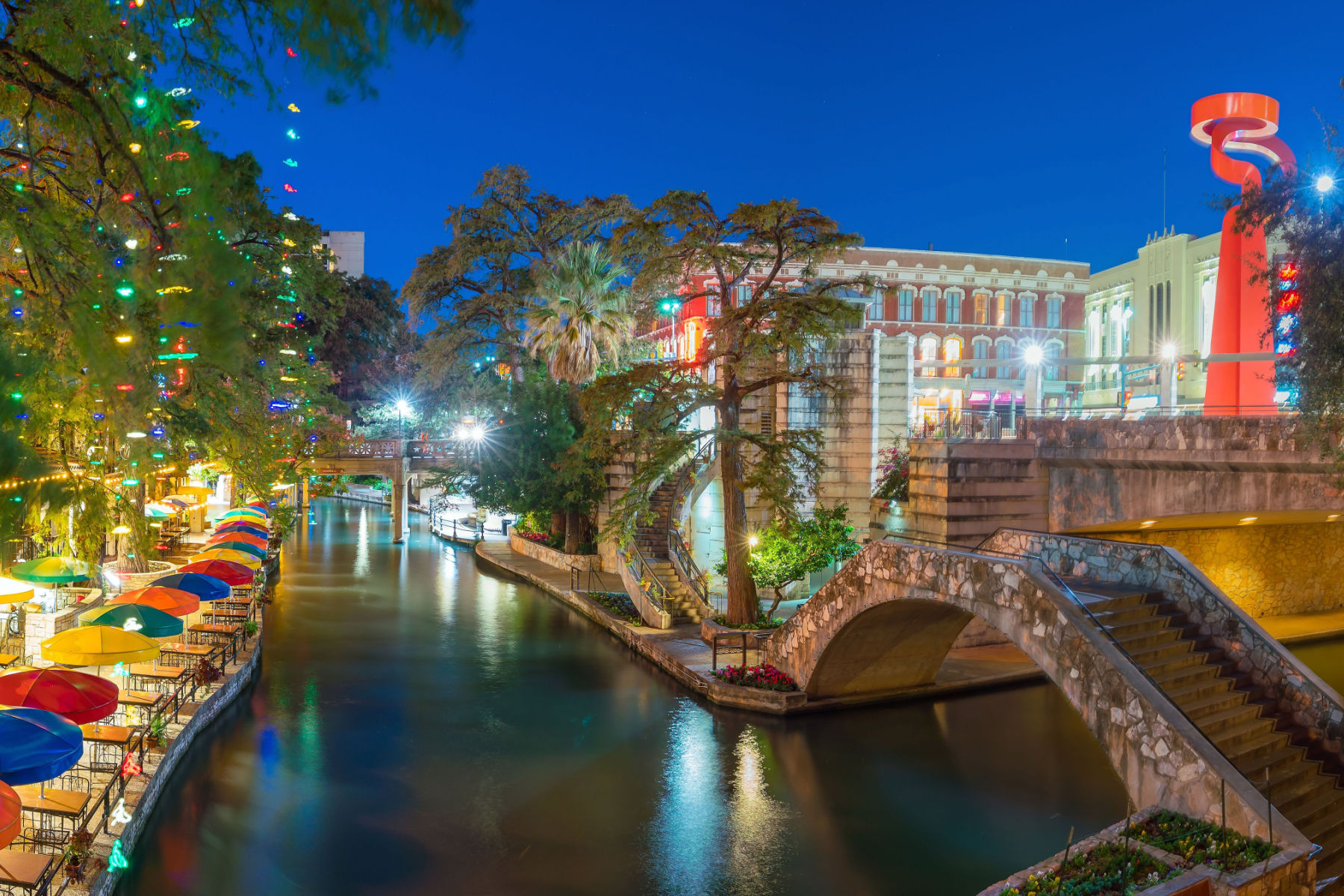
16. Dealey Plaza Historic District
Texas has a rich history, but its not without its dark side. Our next landmark examines one of the greatest tragedies in America’s history.
At #16 on our list of the Best Texas Landmarks is Dealey Plaza Historic District.
Dealey Plaza Historic District is a public park and historic site located in downtown Dallas, Texas.
The site is perhaps best known as the location of the assassination of President John F. Kennedy on November 22, 1963, an event that had a profound impact on American history and culture.
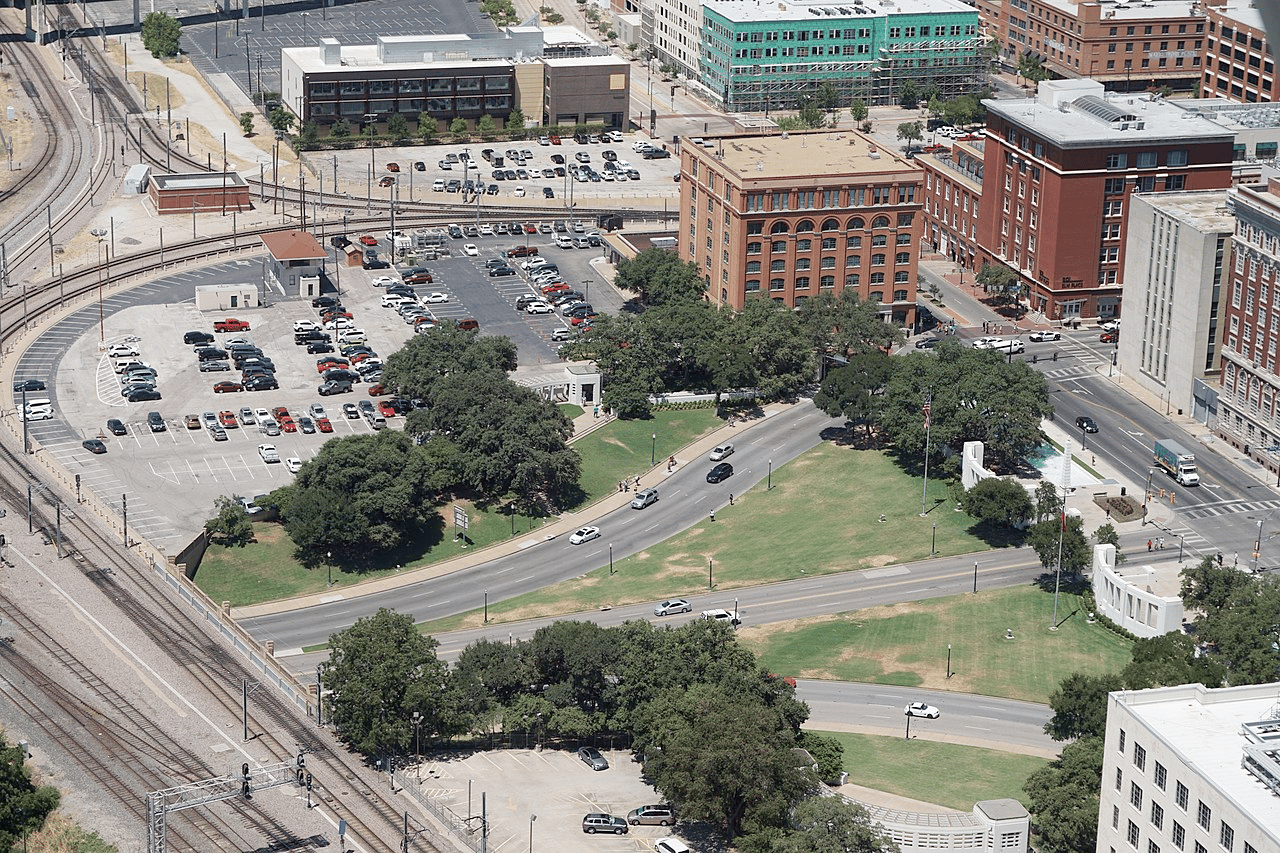
The plaza itself is a small park with a triangular layout, surrounded by several historic buildings, including the Texas School Book Depository, the former headquarters of the Dallas Morning News, and the Old Red Courthouse.
The plaza is also home to several notable monuments and memorials, including the John F. Kennedy Memorial, which is located in the center of the plaza and features a simple, white concrete slab inscribed with the president’s name.

Explore Historic Buildings Or Take Guided Tours
Visitors to Dealey Plaza can explore the site and its historic buildings on their own or take guided tours led by knowledgeable staff. The plaza and its surrounding buildings have been preserved and restored to their 1960s appearance, offering a powerful and immersive experience of the events that took place there.
In addition to its historical significance, Dealey Plaza is also an important cultural destination, attracting visitors from around the world who come to pay their respects to the memory of President Kennedy and to learn more about the events of that fateful day.
The site is a powerful reminder of the enduring impact of history on our lives, and it continues to inspire and educate visitors of all ages and backgrounds.
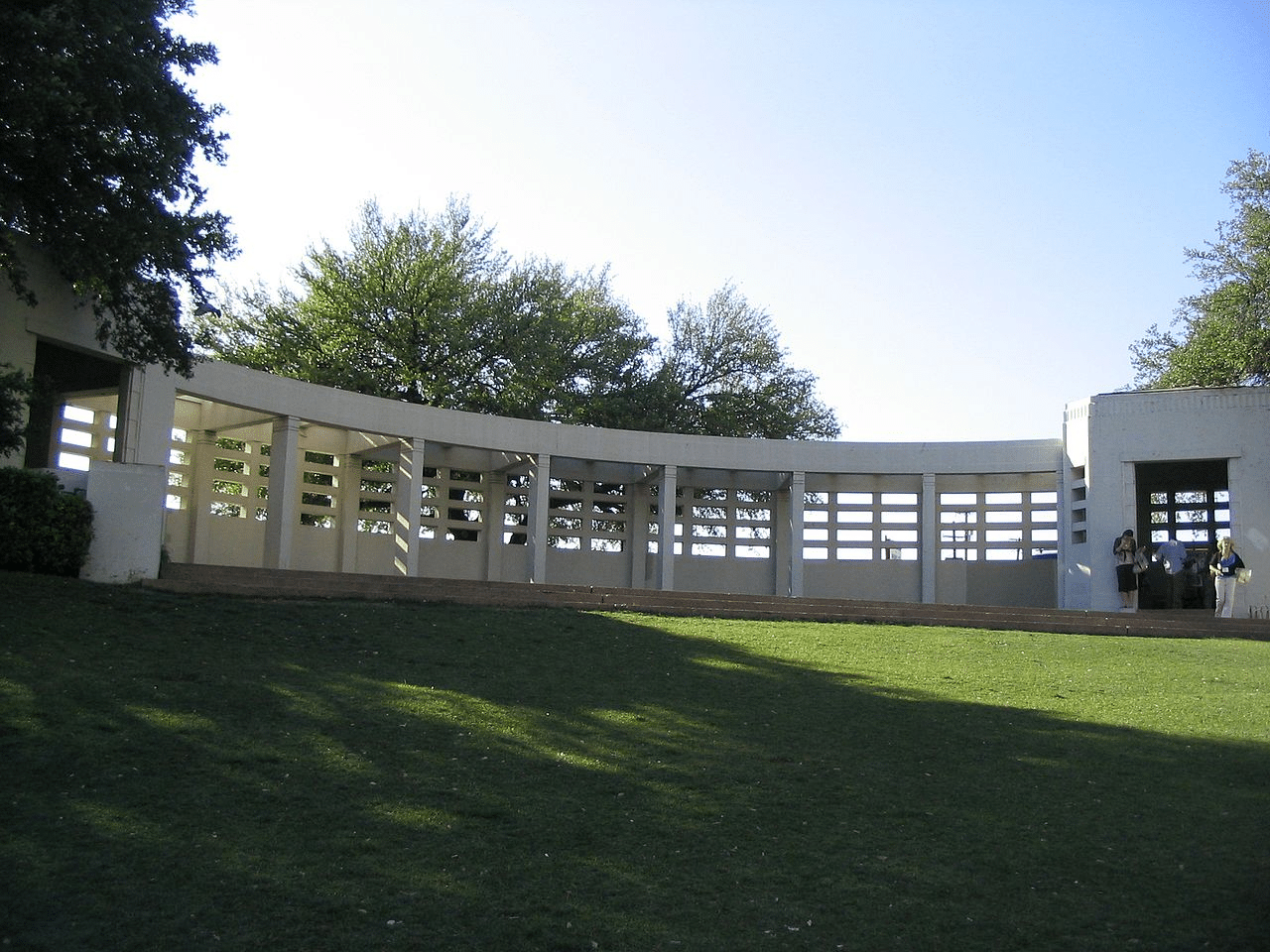
Top 15 Texas Landmarks
15. AT&T Stadium
We’re on to our Top 15 Texas landmarks. Our next landmark is one which is quite popular with sports enthusiasts. At #15 on our list of the Best Texas Landmarks is AT&T Stadium – home of the Dallas Cowboys.
AT&T Stadium, also known as “Jerry World” after Dallas Cowboys owner Jerry Jones, is a massive sports and entertainment venue located in Arlington, Texas.

AT & T Stadium | Courtesy of Wikimedia Commons
A Brief History Of The Stadium
- Planning and Construction: The idea for a new home for the Dallas Cowboys football team began in the late 1990s, and plans for the stadium were announced in 2004. Construction began in 2006 and took nearly four years to complete.
- Design: The stadium was designed by architecture firm HKS, and its unique retractable roof was inspired by the shape of a saddle and the opening and closing mechanism of a camera aperture. The stadium also features a massive video screen suspended over the field, which is one of the largest in the world.
- Opening: AT&T Stadium officially opened on May 27, 2009, with a concert by country music star George Strait. The first football game played at the stadium was a pre-season matchup between the Dallas Cowboys and the Tennessee Titans on August 21, 2009.
- Events: Since its opening, AT&T Stadium has hosted a wide range of events beyond football games, including concerts, college football games, and boxing matches. One of the most notable events was Super Bowl XLV in 2011, which set a record for the largest attendance at a Super Bowl game.
- Technology: AT&T Stadium is known for its cutting-edge technology, including a state-of-the-art sound system and a high-speed Wi-Fi network that can support up to 100,000 simultaneous connections. The stadium also has a mobile app that allows fans to order food and drinks, purchase tickets, and watch replays from their seats.
- Legacy: AT&T Stadium has become one of the most iconic sports venues in the world, and its influence can be seen in the design of other new stadiums, such as the Mercedes-Benz Stadium in Atlanta and the Allegiant Stadium in Las Vegas. It has also played a significant role in the revitalization of the surrounding area, which has seen a surge in development and tourism since the stadium’s opening.

14. Alibates Flint Quarries National Monument
While we’re More Than Just Parks, that doesn’t mean that we’ve forgotten about them. Some of our favorite landmarks are also national park sites.
And, at #14, the Alibates Flint Quarries National Monument is a great example.
If you love rocks then you’re in for a real treat. Alibates Flint is agatized dolomite, or silicified dolomite. Many archeologists refer to it as Alibates chert because of its vibrant colors.
The colors in this type of flint include red, orange and yellow. They’re created by iron; blues and deep greens are usually created by manganese. At this national monument, you’ll have the opportunity to explore these magnificent rocks. (Source: NPS)
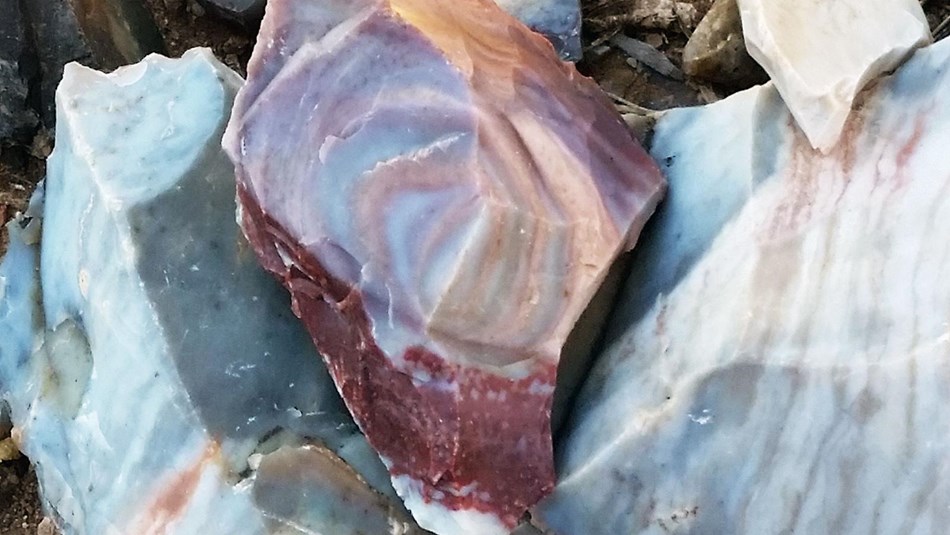
Visitor Center At Alibates Flint Quarries National Monument
If you’re a first-timer then I always recommend beginning your visit at the Visitors Center. The Alibates Visitor Center is open Saturday through Wednesday, 9:00 a.m. to 4:00 p.m. (Except on Thanksgiving and Christmas Day)
The Visitors Center offers a variety of different activities. These include: Museum Exhibits, Ranger-guided quarry tours, an award winning film about Alibates Flint Quarries National Monument, Jr. Ranger Program\Activities and access to the Mesquite Trail which is a self-guided trail.
While you’re there, I also recommend taking the self guided tour of the Alibates Gardens and visiting the Monarch Butterfly Waystation.

13. Camino Real de Tierra Adentro National Historic Trail
We’re just getting warmed up as our landmark on the More Than Just Parks list of the Best Texas Ladnmarks is a special place where you’ll have an opportunity to get in your steps.
At #13, we have the Camino Real de Tierra Adentro National Historic Trail.
The El Camino Real de Tierra Adentro National Historic Trail extends 404 miles between El Paso, Texas to Santa Fe, New Mexico At one time, the historic trail extended all the way to Mexico City.
This trail tells that story of 300 years of conflict, cooperation, and cultural exchange between a variety of empires—European and non-European alike.
There are a variety of wonderful activities for you to choose from along this trail. They include:
- A variety of hiking opportunities across the full length of the trail.
- A visit to the missions along the El Camino Real de Tierra Adentro.
- Museums along the El Camino Real de Tierra Adentro featuring interpretive exhibits, information, and programs.
- Historic sites along the El Camino Real de Tierra Adentro.
For specific information pertaining to sites in New Mexico, please check out this interactive map provided by the National Park Service.

12. Historic Fredericksburg
Now if you’re a history buff then our next landmark has a name that’s likely familiar to you though this is not that site. At #12 on our list of the Best Texas Landmarks is Fredericksburg.
Not to be confused with the town in Virginia of the same name, this Fredericksburg was founded on May 8, 1846 by German immigrants under the Society for the Protection of German Immigrants in Texas.
John O. Meusebach chose the location for the second of the Society’s colonies four miles north of the Pedernales River between two creeks. He named the settlement Friedrichsburg (later changed to Fredericksburg) to honor Prince Frederick of Prussia. Settlers received lots in town with an additional 10 acre lot outside of town.
The colonists planted corn, built storehouses to protect their provisions and trade goods, and prepared for the arrival of more immigrants, who came throughout the summer.
By 1850, census records stated that the town had 754 residents, and Gillespie County had 1,235 residents. (Source: City of Fredericksburg, Texas)

Things To Do
The Pioneer Museum located in downtown Fredericksburg offers a glimpse into the nineteenth and twentieth century settling of this region of Texas by German immigrants.
The museum complex covers a little over three acres and houses multiple buildings to tour. The grounds contain a historic homestead, an old schoolhouse, a barn, a bathhouse, and a smokehouse.

11. Perot Museum of Nature and Science
At our next Texas landmark, you can race a T. rex, challenge friends in robot competitions, explore the astonishing links between dinosaurs and modern-day birds, experience a simulated earthquake, journey through the universe, and test what it means to “be human”.
At #11 on our list of the Best Texas Landmarks is the Perot Museum of Nature and Science.
The Perot Museum of Nature and Science is named after Ross Perot, a Texas businessman and philanthropist who donated $50 million towards its construction. The museum opened in 2012 and has since become a popular destination for locals and visitors alike.

Perot Museum of Nature and Science | Courtesy of Wikimedia Commons
Five Floors Of Interactive Exhibits
The Perot Museum features five floors of interactive exhibits that explore a variety of scientific topics, including geology, paleontology, biology, astronomy, and engineering. Some of the highlights of the museum include:
- The T. Boone Pickens Life Then and Now Hall, which features a collection of fossils, interactive exhibits, and life-size models of prehistoric creatures, including a Tyrannosaurus rex.
- The Rose Hall of Birds, which showcases hundreds of bird specimens from around the world and includes interactive exhibits about bird behavior and conservation.
- The Moody Family Children’s Museum, which is designed for children ages 5 and under and features a variety of hands-on exhibits that encourage exploration and play.
- The Being Human Hall, which explores the biology and behavior of humans and includes interactive exhibits about the brain, the senses, and human evolution.
- The Lyda Hill Gems and Minerals Hall, which features a stunning collection of gems, minerals, and meteorites from around the world.
The museum also has a 3D theater, a planetarium, and a variety of temporary exhibits that rotate throughout the year. Overall, the Perot Museum of Nature and Science offers a fun and engaging learning experience for visitors of all ages.

Top 10 Texas Landmarks
10. Fort Davis National Historic Site
We’re on to our Top 10 Texas landmarks and, as mentioned earlier, Texas is a state that’s rich in history. That includes the Winning of the West. Our next landmark explores this chapter in American history. At #10 is the Fort Davis National Historic Site.
Fort Davis is one of the best surviving examples of an Indian Wars’ frontier military post in the Southwest.
From 1854 to 1891, it was strategically located to protect emigrants, mail coaches, and freight wagons on the Trans-Pecos portion of the San Antonio-El Paso Road and on the Chihuahua Trail.
This Site Contains Some Wonderful Hiking Trails
These trails include the following:
- Photographers Trail-This is the only trail on Sleeping Lion Mountain, a short hike offers great photographic opportunities without the commitment of a long hike.
- Tall Grass Loop Trail-This hike is steep and strenuous along the trail switchbacks of the trail there are stairs on certain portions. Along the northern route of the trail, can become slick after precipitation. This trail is 0.8 mi (1.3 km) long one way.
- Scenic Overlook Trail-This hike is steep and strenuous along the switchback portion of the trail utilizing stairs with rails. The trail offers panoramic views of Fort Davis NHS. The trail is 0.4 miles (0.6km) long one way.
- Hospital Canyon Trail-This trail is strenuous along the switchback portions and there are sections without shade.
- North Ridge Trail-This hike allows you to walk between Rhyolite boulders and experience the 360° views of the Davis Mountains.
- Cemetery Trail-The Cemetery Trail is .2mi (.3km) long one way, this short hike takes you to the location of the post-Civil War Cemetery. (Source: NPS)
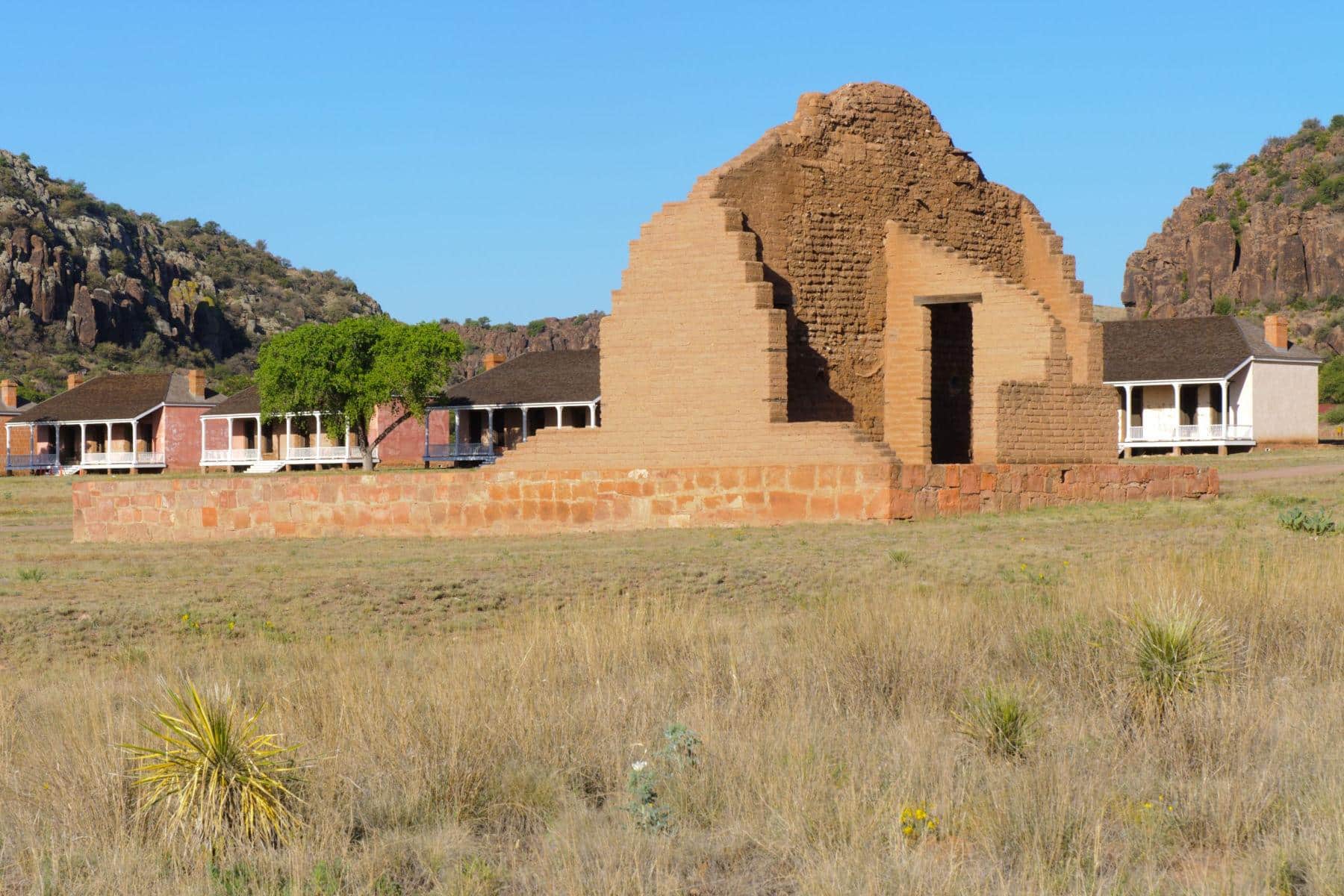
9. John F. Kennedy Memorial Plaza and The Grassy Knoll
The history of Texas is inextricably linked to the tragic events of November 22nd, 1963. Our next Texas Landmark is a tribute to what happened on the fateful day.
At #9 on our list of the Best Texas Landmarks is the John F. Kennedy Memorial Plaza and The Grassy Knoll.
The John F. Kennedy Memorial Plaza and The Grassy Knoll are both significant landmarks associated with the assassination of President John F. Kennedy on November 22, 1963.
The John F. Kennedy Memorial Plaza is a simple, open-air monument designed by architect Philip Johnson. The monument consists of a square, roofless room with four pillars at each corner and a large, white, concrete slab in the center engraved with Kennedy’s name and the dates of his birth and death.

President & Mrs. Kennedy arriving in Dallas, 11\22\63 | Courtesy of Wikimedia Commons
The Monument Is Meant To Symbolize Kennedy’s Spirit & Vision
The monument is meant to symbolize Kennedy’s spirit and vision, and visitors often leave flowers, notes, and other mementos in remembrance of the late president.
The Grassy Knoll is a small hill located adjacent to the John F. Kennedy Memorial Plaza, and it gained notoriety as a possible location from where the fatal shots were fired that killed President Kennedy.
Many conspiracy theories have suggested that a second gunman fired from the Grassy Knoll, although this has been the subject of much debate and remains unproven.
Today, both the John F. Kennedy Memorial Plaza and The Grassy Knoll are popular tourist destinations and serve as a somber reminder of the tragic events that took place in Dealey Plaza over half a century ago.
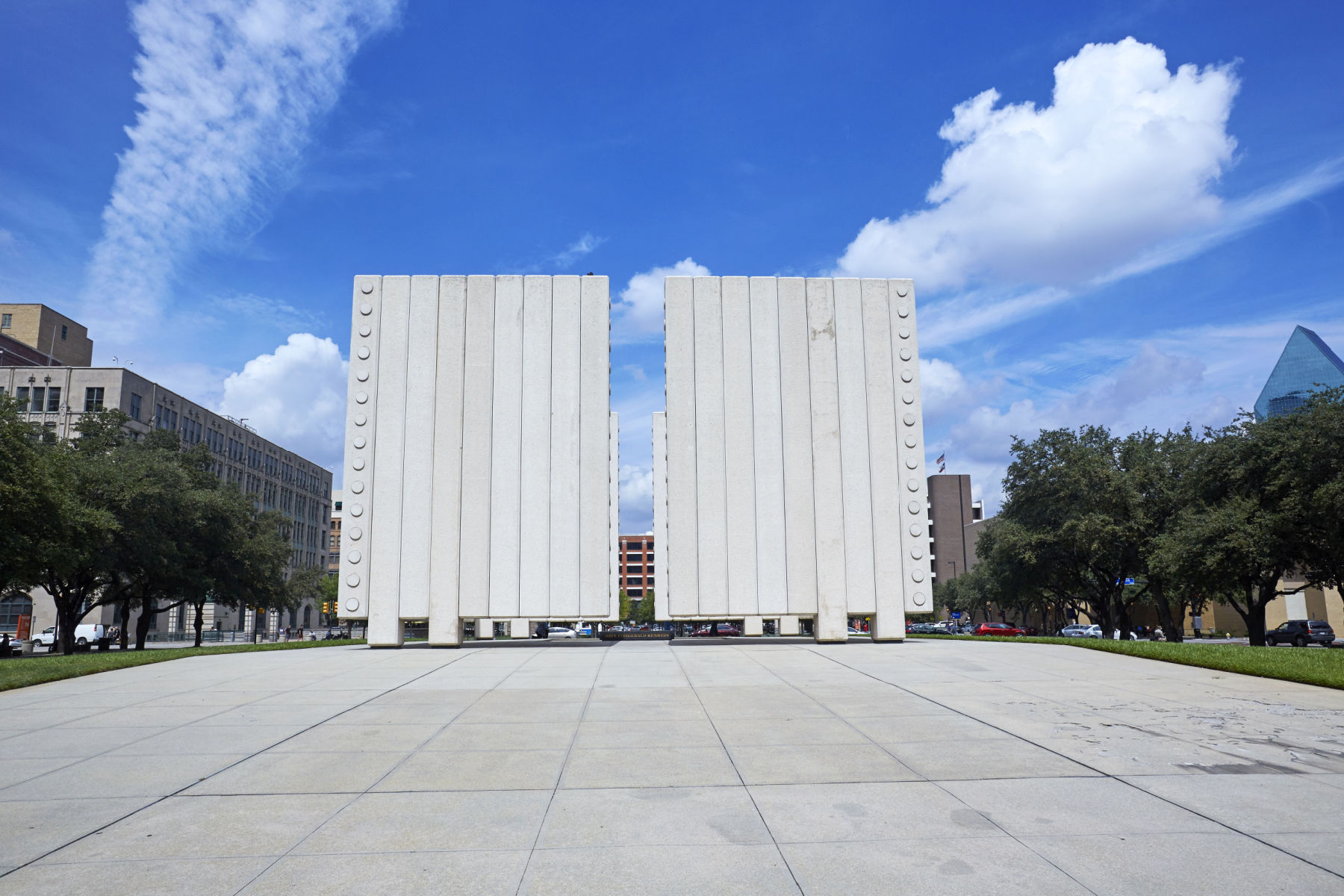
8. Waco Mammoth National Monument
Now if you’re someone who likes ancient history then our next Texas landmark is for you. It’s a place where you can walk in the footsteps of creatures as tall as 14 feet and weighing 20,000 pounds.
At #8 on our list of the Best Texas Landmarks is Waco Mammoth National Monument.
The park is named after the discovery of the remains of mammoths and other Ice Age animals that lived approximately 68,000 to 70,000 years ago.
The discovery of the fossil remains in 1978 led to the establishment of the monument, which has since become an important destination for scientists, students, and visitors interested in learning about the natural history of the region and the creatures that lived there.
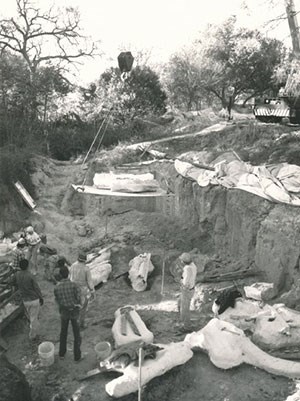
It’s An Important Piece Of America’s Natural History
Since its discovery, museum staff, students, and volunteers have worked tirelessly to excavate and preserve the fossil material, spending thousands of hours on the effort.
In 1990, some of the fossils excavated from the site were transferred to the Baylor University’s Mayborn Museum Complex, while others remain in their original position within the bone bed. These specimens are now protected by a climate-controlled Dig Shelter, which allows for both public viewing and further scientific study.
The Waco Mammoth National Monument is an important piece of America’s natural history, and its preservation and protection is essential for future generations to understand the story of the earth and the creatures that lived on it.

Entrance sign at the Waco Mammoth Site before it became Waco Mammoth National Monument | Courtesy of Wikimedia Commons
7. Palo Alto Battlefield National Historical Park
If you’re familiar with the history of this amazing state then you know that Texas role in achieving its independence is considered to be the most important chapter of the state’s history by many local historians.
Part of this achievement came about as a result of the Mexican-American War which followed Texas own struggle for independence. At #7 on our list of the Best Texas Landmarks is Palo Alto Battlefield National Historical Park.
The site is dedicated to preserving the site of the first battle of the Mexican-American War, which was fought on May 8, 1846.
The park provides visitors with a glimpse into the events that led to the war and the role that this battle played in shaping the history of the United States.
Visitors can explore the park’s visitor center, which contains exhibits about the war and the battle, as well as a picnic area, trails, and a scenic drive.
The park also offers educational programs and special events throughout the year, making it an ideal destination for history buffs and anyone interested in learning more about this important moment in American history.
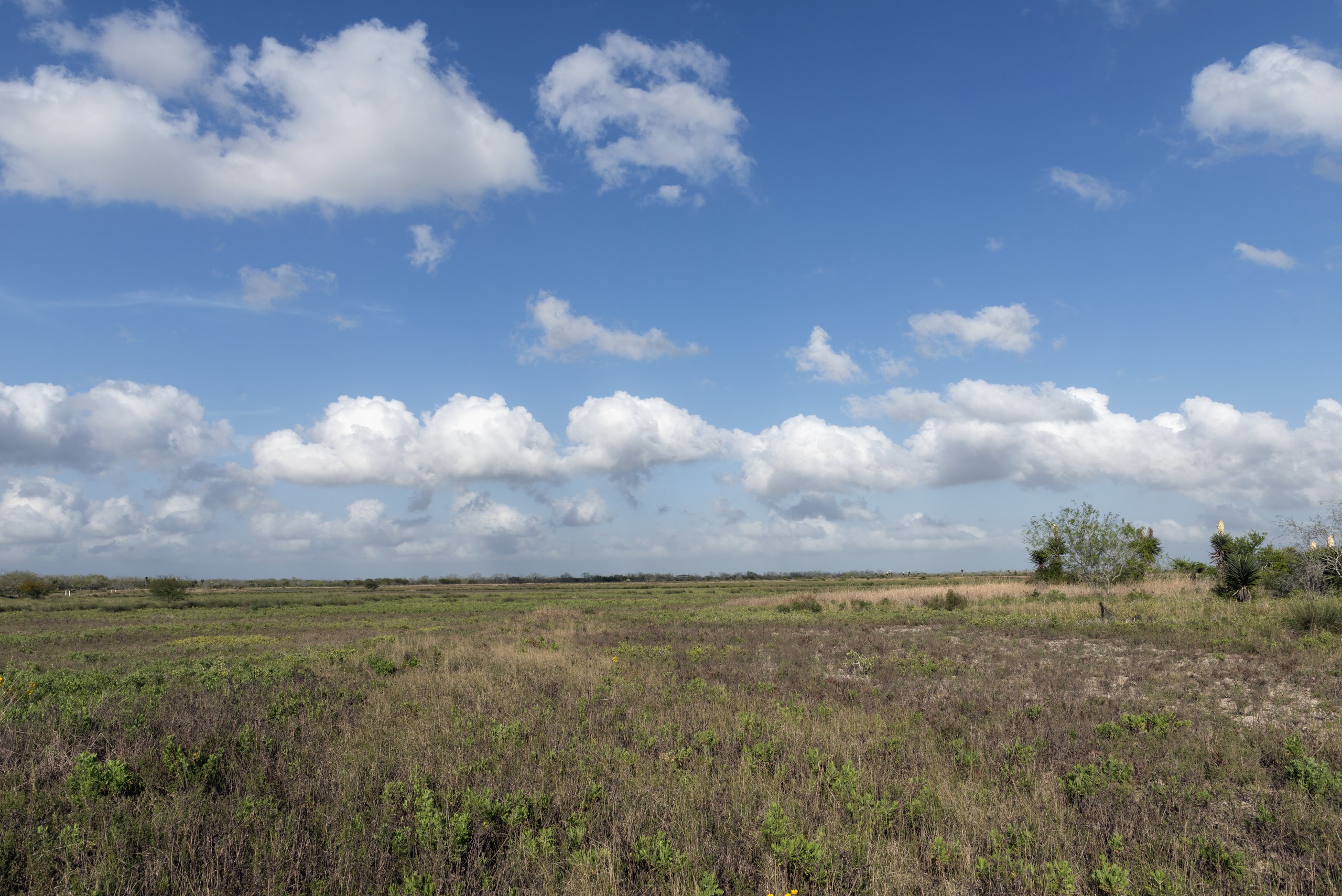
Step Back In Time At Palo Alto
I recommend that you begin your visit at the Visitor Center and pick up a park brochure and trail guide. From there you will discover outdoor adventures which include:
- Hiking the battlefield trail which is a half-mile walk. Along the way you will see a landscape very much like the one experienced by soldiers in 1846.
- From Palo Alto you can also explore the Brownsville Historical Trail which includes historic sites and attractions.
- Bird watching is highly recommended too. All you have to do is bring a pair of binoculars with you and keep a watchful eye out as you traverse the trail.
- Visit the Resaca de la Palma Battlefield which features a half-mile circular trail with interpretive waysides.
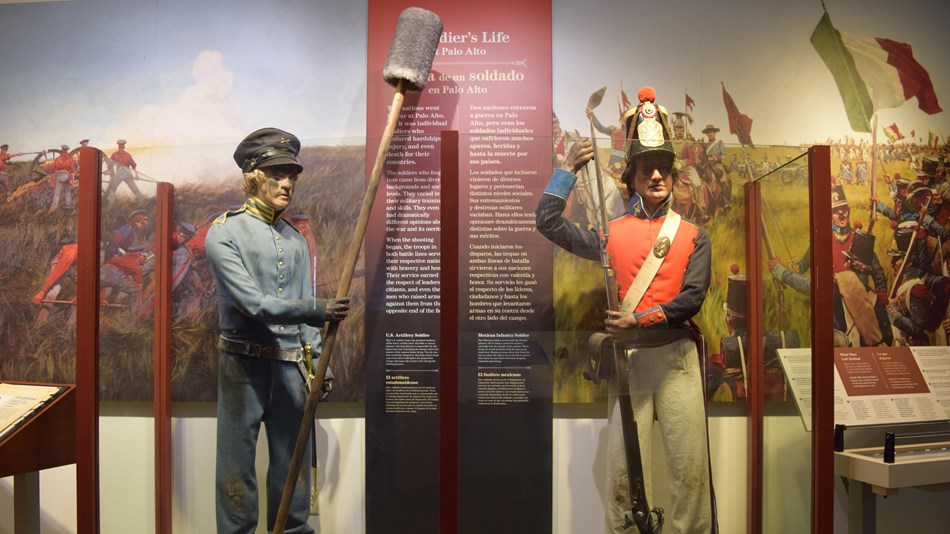
6. San Antonio Missions National Historical Park
Our next Texas landmark played a major role in all aspects of Spanish colonial frontier life as they related to religion, the military, culture, and agriculture.
At #6 on our list of the Best Texas Landmarks is the San Antonio Missions National Historical Park.
The Spanish Missions in Texas were religious outposts established by Spanish priests and colonial authorities to spread the Catholic doctrine among Native Americans. They were also, however, the place that western thought and ideas were first introduced to this region of the country.
The general purpose of the missions was to “reduce” or congregate the often nomadic tribes into a settlement, convert them to Christianity, and teach them crafts and agricultural techniques. The San Antonio Missions National Historical Park is dedicated to preserving the history of the Spanish missions in the area.

The Park Encompasses Four Spanish Missions
The park encompasses four of the five Spanish missions that were established in the early 18th century in order to spread Christianity among the native populations and to create a Spanish colonial presence in the region.
These missions, known as the Alamo, Concepción, San José, and San Juan, were an important part of the cultural and religious heritage of Texas and the American Southwest.
The missions were in use for over 70 years before being abandoned in the late 18th century. Over time, the buildings fell into disrepair and were eventually restored and preserved as a National Historical Park in 1978.
Today, visitors to the park can explore the well-preserved ruins of the missions, which offer a glimpse into the everyday lives of the Spanish colonists and the indigenous people who lived there.
The park also provides educational programs and special events, making it an ideal destination for history buffs, families, and anyone interested in learning about the Spanish missions and their role in shaping the cultural heritage of the American Southwest.
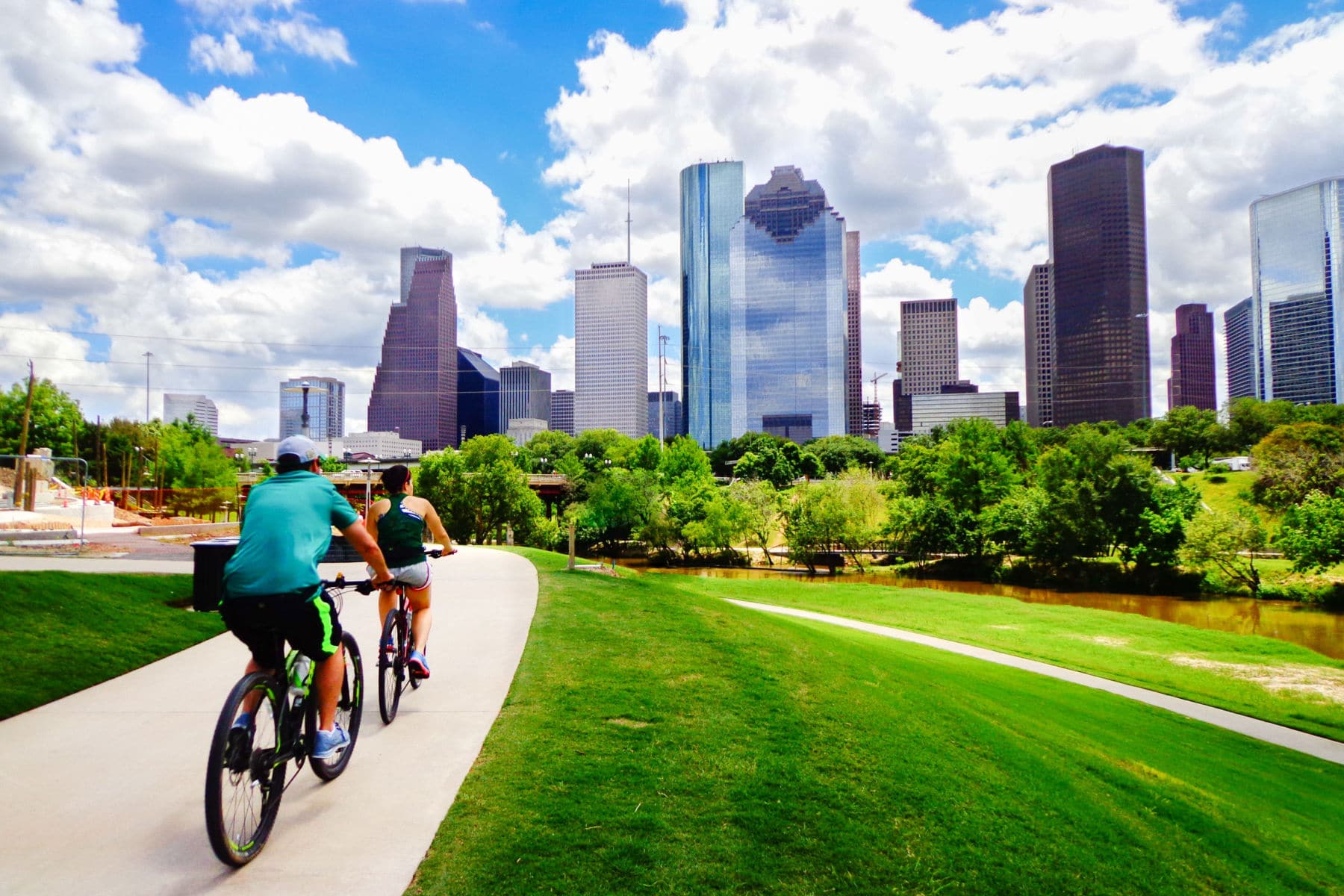
Top 5 Texas Landmarks
5. Southfork Ranch
We’re on our Top 5 Texas landmarks. Our next landmark is an iconic ranch which has been inextricably linked to the city of Dallas due to the enduring popularity of a 1980s television program. At #5 on our list of the Best Texas Landmarks is Southfork Ranch.
Southfork Ranch is a famous tourist destination located in Parker, Texas, just north of Dallas. The ranch gained worldwide recognition as the setting for the popular television series “Dallas,” which aired from 1978 to 1991.
The ranch itself has a long and storied history dating back to the early 1900s. Originally known as the “Duncan Acres,” the ranch was purchased in 1950 by oil tycoon, Joe Duncan, and his wife, Sophie. They renamed it “Southfork Ranch” and began to develop the property as a cattle ranch and equestrian center.
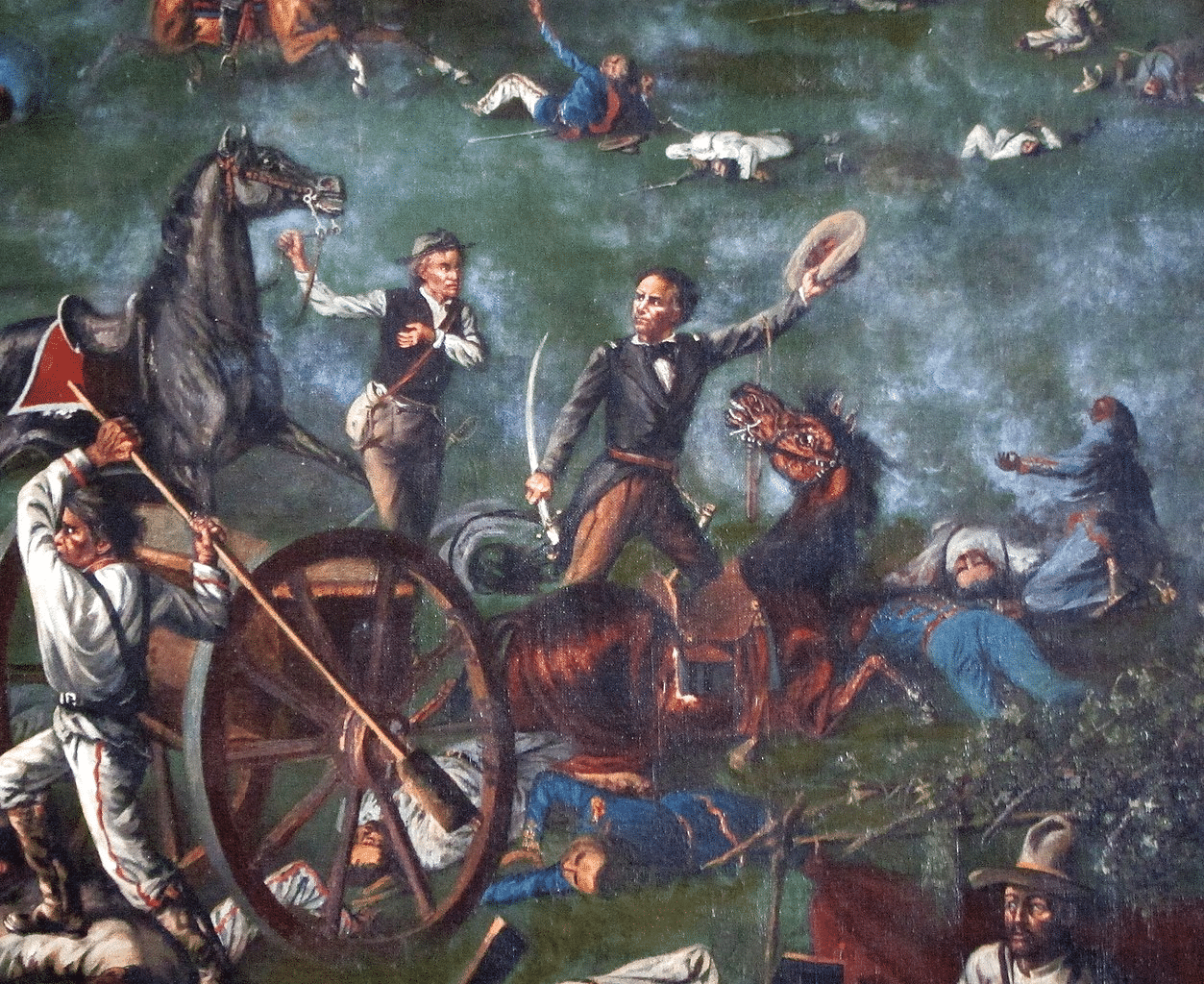
Map of Southfork Ranch area | Courtesy of Wikimedia Commons
The Ranch Was Purchased By A Hollywood Actor
In the early 1970s, Southfork Ranch was purchased by the actor, Joel McCrea, who had a passion for horses and ranching. He expanded the property, adding new facilities and amenities, and began to host charitable events and horse shows.
In 1978, Southfork Ranch gained worldwide fame when it was chosen as the filming location for the television series “Dallas.” The ranch was used as the home of the fictional Ewing family, and many iconic scenes from the show were filmed on the property. The popularity of the show led to a surge in tourism, and Southfork Ranch became a popular destination for fans of the show.
In 1985, the ranch was purchased by the current owners, the Muns family, who have continued to operate it as a tourist destination. Today, visitors can tour the ranch, see memorabilia from the “Dallas” series, and enjoy a variety of activities and events, such as horseback riding, cattle drives, and trail rides.
Overall, Southfork Ranch has a rich history as a working cattle ranch, an equestrian center, and a filming location for one of the most popular television shows of all time. Today, it continues to be a beloved tourist destination and an important part of Dallas’s cultural heritage.
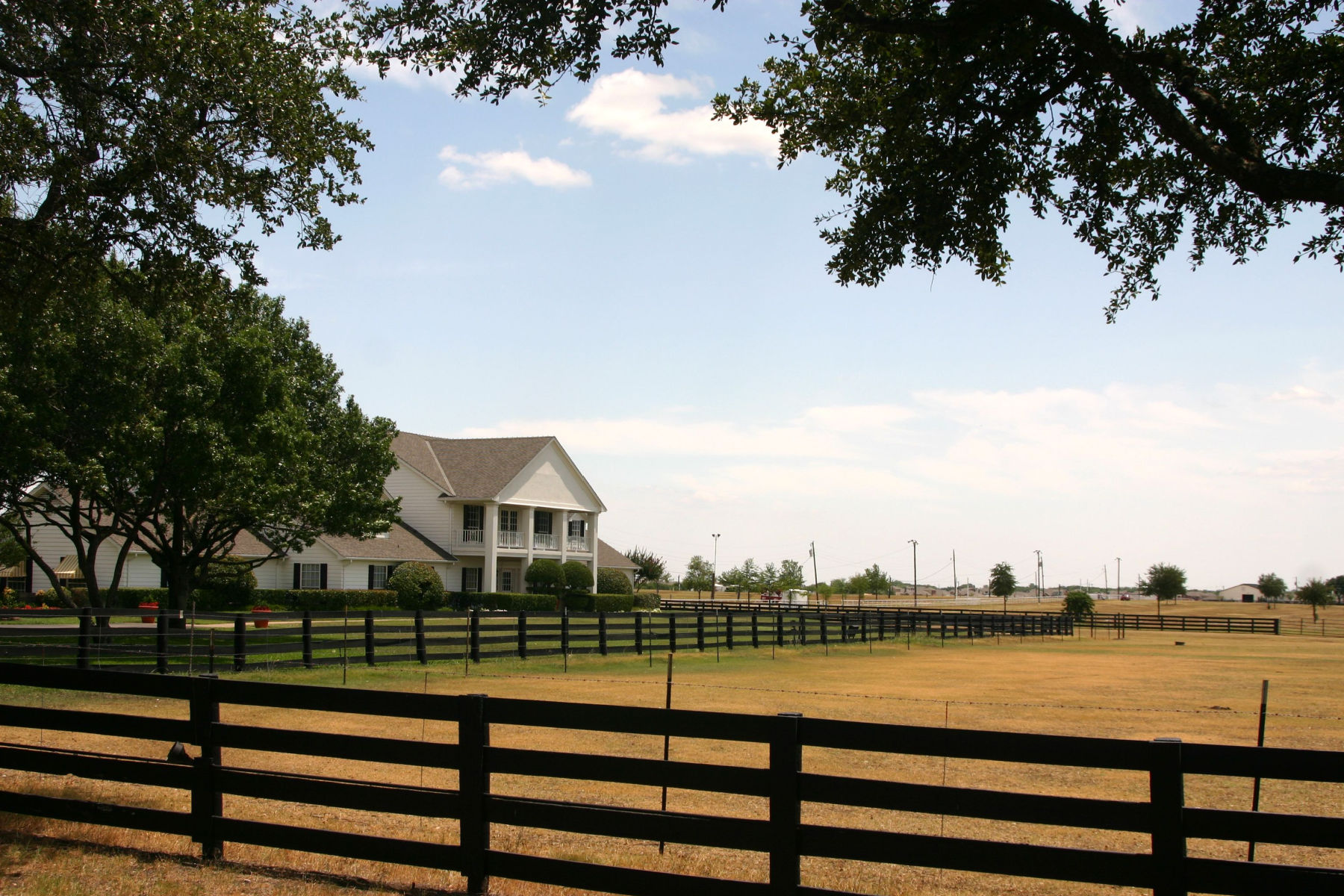
4. Lyndon B. Johnson National Historical Park
We’re down to the final four on More Than Just Parks list of the Best Texas Landmarks. At #4 is a site which celebrates Texas most famous native son. It’s the Lyndon B. Johnson National Historical Park.
The Lyndon B. Johnson National Historical Park is dedicated to preserving and interpreting the life, career, and legacy of President Lyndon B. Johnson, who served as the 36th President of the United States from 1963 to 1969.
The park includes several sites related to Johnson’s life, including the Johnson Family Ranch, where he was born and raised, and the Johnson Settlement, which includes the boyhood home of President Johnson, his grandparents’ home, and other associated buildings.
Visitors to the park can tour the Texas White House, which served as the President’s informal office during his time in office, and see exhibits about his life and presidency, including his role in the Civil Rights Movement, the Great Society programs, and the Vietnam War.
The park also offers a variety of educational programs and events, including ranger-led tours, special events, and living history demonstrations, making it an ideal destination for history buffs, families, and anyone interested in learning more about one of America’s most important leaders.
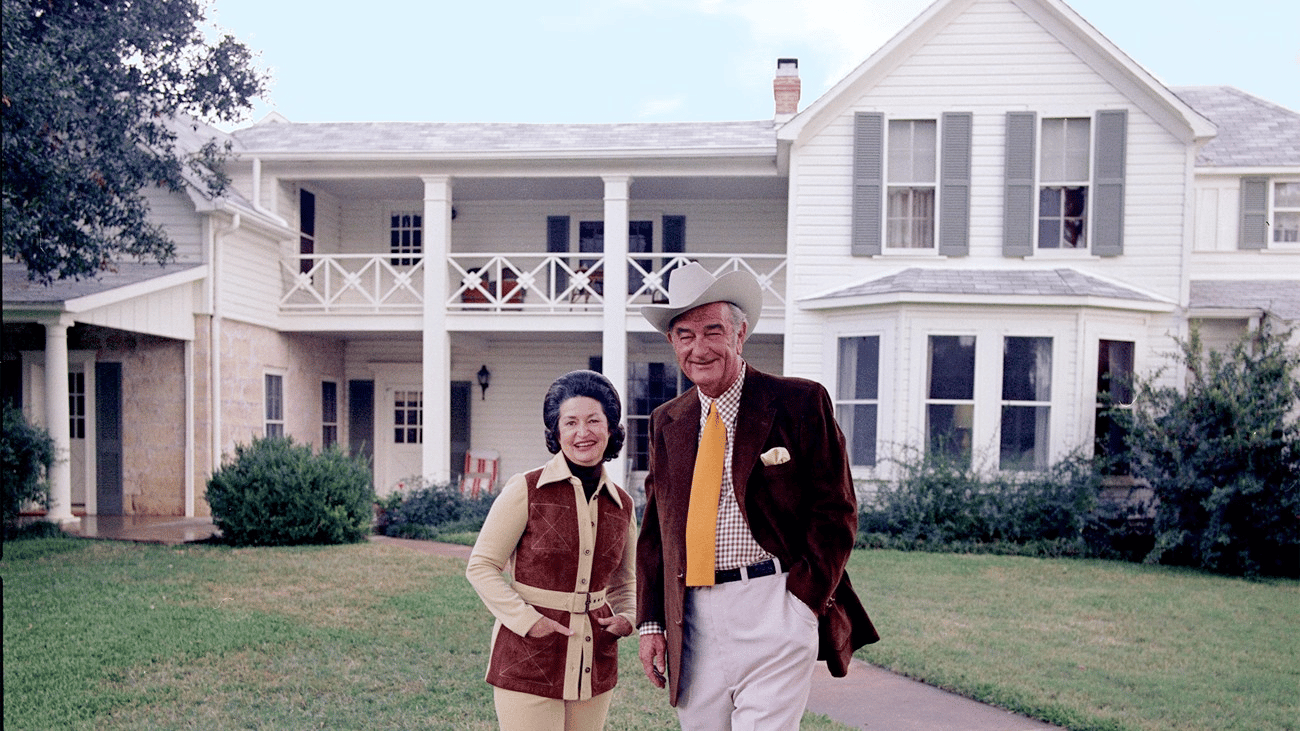
His Presidency Began & Ended With Tragedy
As Kent Germany, associate professor of history at the University of South Carolina notes, Lyndon Johnson’s presidency began and ended with tragedy. He came into office after the death of a popular young President and provided needed continuity and stability.
He advanced the Kennedy legacy, obtaining far more than Kennedy would likely have gotten out of Congress, and then won a huge landslide victory for himself and his party.
President Johnson’s administration also extended the New Deal of Franklin Roosevelt, including aid to education, Headstart, Medicare, and Medicaid—programs that are still significant today and that command bipartisan support for their effectiveness.
While his programs kept untold numbers of Americans out of poverty, gave others basic health care, and ensured the fundamental rights of citizenship for minorities, in Southeast Asia, millions of Vietnamese lost their lives and homes, more than 58,000 American military personnel lost their lives, and hundreds of thousands more would have their lives permanently altered.

Take A Deeper Dive Into The Life & Times Of Lyndon Johnson
If you’re interested in taking a deeper dive then we recommend what many consider to be the best biographical series ever written on LBJ.
Robert Caro is an American journalist and biographer. He is best known for his multi-volume biography of former U.S. President Lyndon B. Johnson. Caro’s work on Johnson is widely considered to be one of the most comprehensive and insightful biographies of a U.S. President.
Caro has won numerous awards for his writing, including two Pulitzer Prizes and several National Book Awards. He is widely regarded as one of the best biographers of his generation, known for his meticulous research, in-depth interviews, and vivid writing style.
I recommend the following books by Robert Caro:
The Years of Lyndon Johnson: The Path to Power; Means of Ascent; Master of the Senate; The Passage of Power. This four volume collection which won the coveted Pulitzer Prize.

3. San Jacinto Battleground State Historic Site
Our next Texas landmark was a place where Texas won its independence from Mexico. It opened the door for the continued westward expansion of the United States. At #3 on our list of the Best Texas Landmarks is the San Jacinto Battleground State Historic Site.
The San Jacinto Battleground State Historic Site commemorates the Battle of San Jacinto, which was fought on April 21, 1836, between the forces of the Republic of Texas and the Mexican Army. It was fought between the Texian army, led by General Sam Houston, and the Mexican army, led by General Antonio López de Santa Anna.
After a series of defeats and setbacks, the Texian army had retreated eastward, pursued by the Mexican army. On April 21, the two armies faced each other across a shallow marshland. Santa Anna believed that he had the advantage and ordered his troops to take a siesta. However, the Texians used this opportunity to launch a surprise attack.
Remember The Alamo
With a battle cry of “Remember the Alamo!” and “Remember Goliad!”, the Texians charged the Mexican lines, catching the Mexican army off guard. In just 18 minutes, the Texians defeated the Mexican army, killing or capturing most of Santa Anna’s forces.
The battle resulted in the capture of Santa Anna himself, who was forced to sign the Treaty of Velasco, recognizing Texas’ independence.
After the battle, the site was used as a military training ground and was also the location of a Confederate prisoner-of-war camp during the Civil War.
In 1874, the state of Texas purchased the site and established it as a public park. In 1890, the Texas legislature authorized the construction of a monument to commemorate the battle.
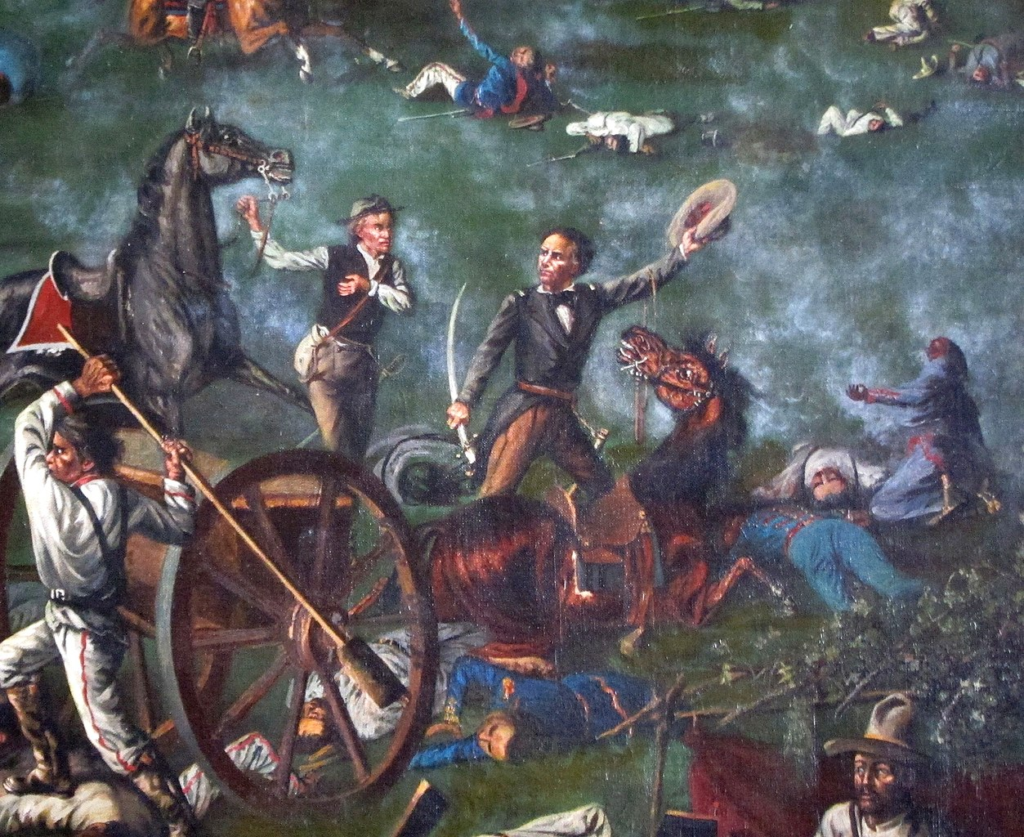
Sam Houston at the Battle of San Jacinto | Courtesy of Wikimedia Commons
The San Jacinto Monument
The San Jacinto Monument was completed in 1939 and is the tallest monument in the world that is dedicated to a battle. It stands 567 feet tall and features an observation deck that offers panoramic views of the surrounding area. The base of the monument contains a museum that features exhibits about the history of the battle and the Texas Revolution.
In addition to the monument and museum, the San Jacinto Battleground State Historic Site also features a number of other attractions, including a replica of the steamship “The Texas,” which played a role in the battle, and the restored home of the Republic of Texas president, Sam Houston.
Today, the San Jacinto Battleground State Historic Site is a popular destination for tourists and history enthusiasts who want to learn about the history of Texas and the United States. It is also a place of remembrance and reverence for those who fought and died in the battle that secured Texas’ independence.
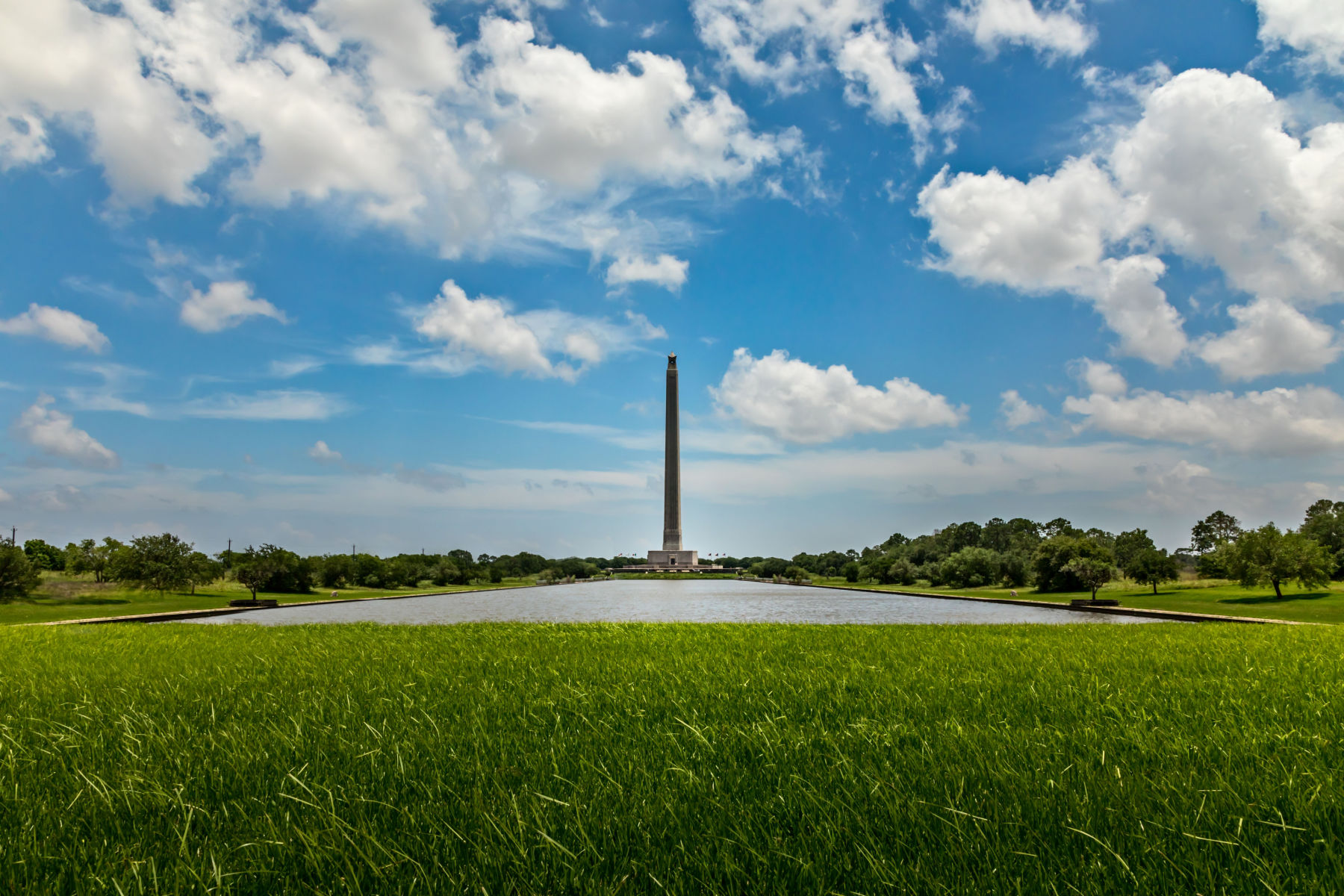
2. NASA Space Center Houston
We’re down to our final 2 Texas landmarks. In the runner-up spot at #2 is a place that’s home to the nation’s astronaut corps, the International Space Station mission operations, the Orion Program, and a host of future space developments.
It plays a pivotal role in enhancing scientific and technological knowledge to benefit all of humankind. Welcome to NASA Space Center Houston.
The NASA Space Center Houston is a science museum and education center located in Houston, Texas. It was established in 1992 as the official visitor center for the nearby Lyndon B. Johnson Space Center, which is NASA’s center for human spaceflight operations.

The History Of The Space Center
The history of the Space Center Houston dates back to the early days of the US space program in the 1960s. The Lyndon B. Johnson Space Center was established in Houston in 1961 as the Manned Spacecraft Center, and it played a critical role in the development of the Apollo program, which sent the first humans to the moon.
As the space program grew, so did the public’s interest in it.NASA began offering public tours of the Space Center in the 1970s, which allowed visitors to see the facilities and equipment used in the space program up close. In 1982, NASA opened the “Space Center Houston” as a smaller visitor center to complement the existing tours.
In the 1990s, the Space Center Houston underwent a major expansion and renovation. The new facility featured a variety of interactive exhibits and educational programs designed to teach visitors about the science and technology behind space exploration. It also included a large screen theater, a space shuttle replica, and numerous displays of actual space hardware, including the Apollo 17 command module and a Saturn V rocket.
Today, the NASA Space Center Houston continues to be a popular destination for tourists and space enthusiasts from around the world. In addition to its exhibits and programs, it also hosts a variety of special events and educational programs, including summer camps and teacher training workshops.
It remains an important hub of research and development in the field of human spaceflight, and it continues to inspire and educate the public about the wonders of space exploration.

Things To Do
Here are some of the most popular activities:
- Take a tram tour: The NASA Space Center offers several tram tours that take visitors to different areas of the Johnson Space Center, including astronaut training facilities and mission control. You can see the historic Saturn V rocket and explore the International Space Station Gallery.
- Visit the exhibits: There are many interactive exhibits that allow visitors to learn about the history and science of space exploration. These exhibits include the Space Shuttle, the Mission Mars exhibit, and the Lunar Samples Vault.
- Meet an astronaut: The NASA Space Center frequently hosts astronauts for meet-and-greet sessions and talks. Visitors can learn about their experiences in space and ask them questions.
- Watch a movie: The Space Center Houston has an IMAX theater that shows space-related movies on a giant screen. The films range from documentaries to Hollywood blockbusters.
- Take part in a simulation: The NASA Space Center offers a variety of simulation experiences, such as the Mars Base 1, where visitors can experience what it might be like to live and work on Mars.
- Attend a special event: Throughout the year, the Space Center Houston hosts special events, such as Space Center Houston’s Galaxy Lights, where the entire center is transformed into a holiday wonderland with light displays, ice skating and much more.
- Explore the Rocket Park: Rocket Park has been home to some of the most significant rockets in NASA’s history. It features restored rockets and mission control displays.
1. The Alamo
Remember the Alamo? Few Texans will ever forget it! The Alamo is to Texans what the Statue of Liberty is to Americans. It’s a historical landmark which symbolizes the struggle for liberty.
It also happens to be our #1 Texas Landmark. After all, how could any list of historic sites in the Lone Star State not place the Alamo at the top?
The Battle of the Alamo during Texas’ war for independence from Mexico lasted thirteen days, from February 23, 1836-March 6, 1836.
In December of 1835, a group of Texan volunteer soldiers had occupied the Alamo, a former Franciscan mission located near the present-day city of San Antonio.
While the Mexican Army under the leadership of Santa Anna prevailed slaughtering all of the soldiers inside of the fort, it was an important event in the Texas Revolution and American History because it rallied the rest of Texas to fight against the Mexican army eventually leading to a victory over Santa Ana at the Battle of San Jacinto.
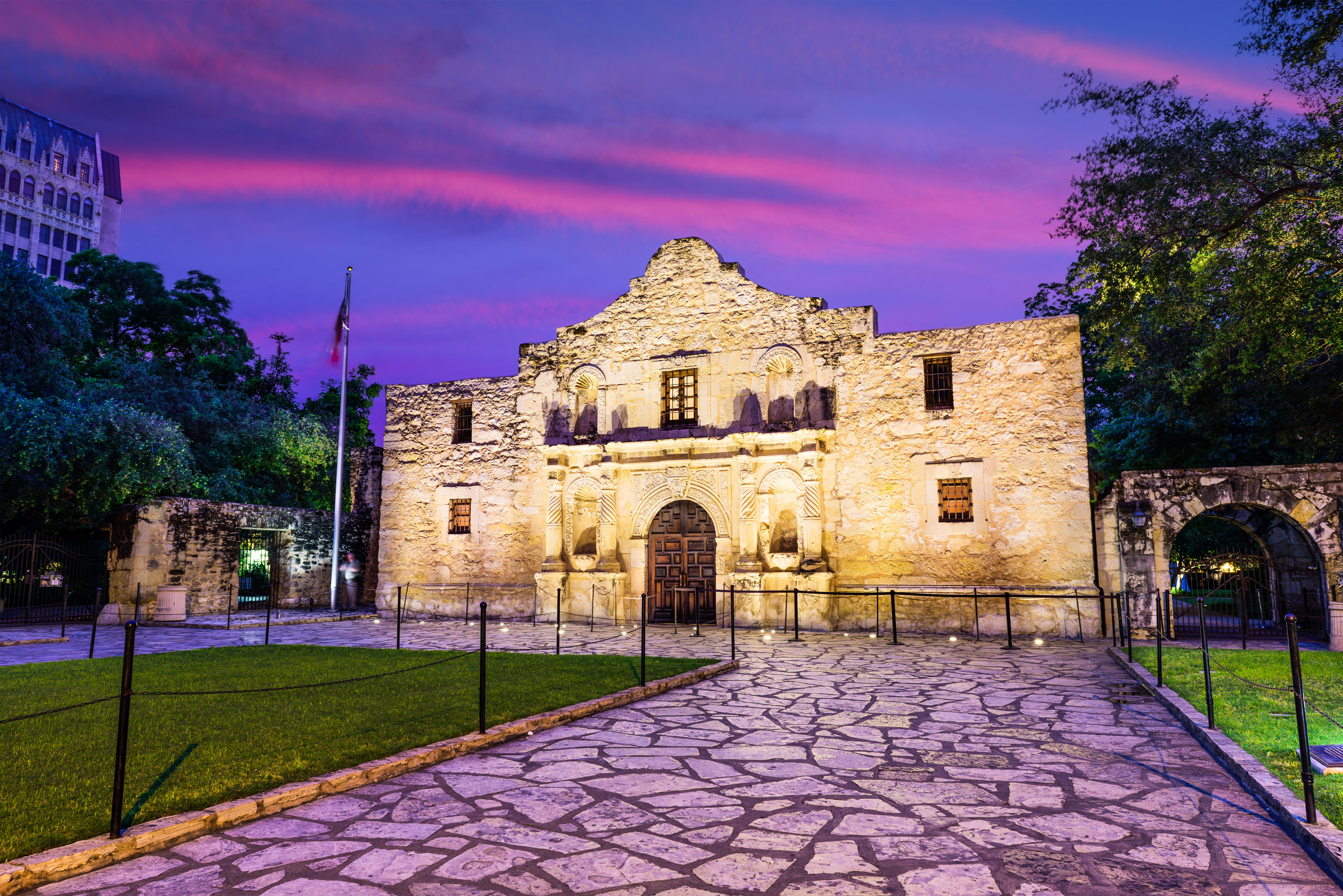
Things To Do At The Alamo
Here are some things that visitors can do at the Alamo:
- Explore the Alamo grounds and buildings: Visitors can explore the historic Alamo Mission and its surrounding gardens and courtyards. The mission was originally built in the 18th century and has been preserved as a museum and historic site.
- Take a guided tour: The Alamo offers a variety of guided tours led by knowledgeable staff, including tours of the mission, the surrounding historic district, and the nearby San Antonio River Walk.
- Learn about the history of the Alamo: Visitors can learn about the history of the Alamo and its significance in Texas history through exhibits, displays, and multimedia presentations at the Alamo Museum.
- Attend events and activities: The Alamo hosts a variety of events and activities throughout the year, including historical reenactments, festivals, and cultural celebrations.
- Shop for souvenirs: The Alamo Gift Shop offers a variety of souvenirs and mementos, including books, apparel, and other items related to the history and culture of the Alamo and Texas.
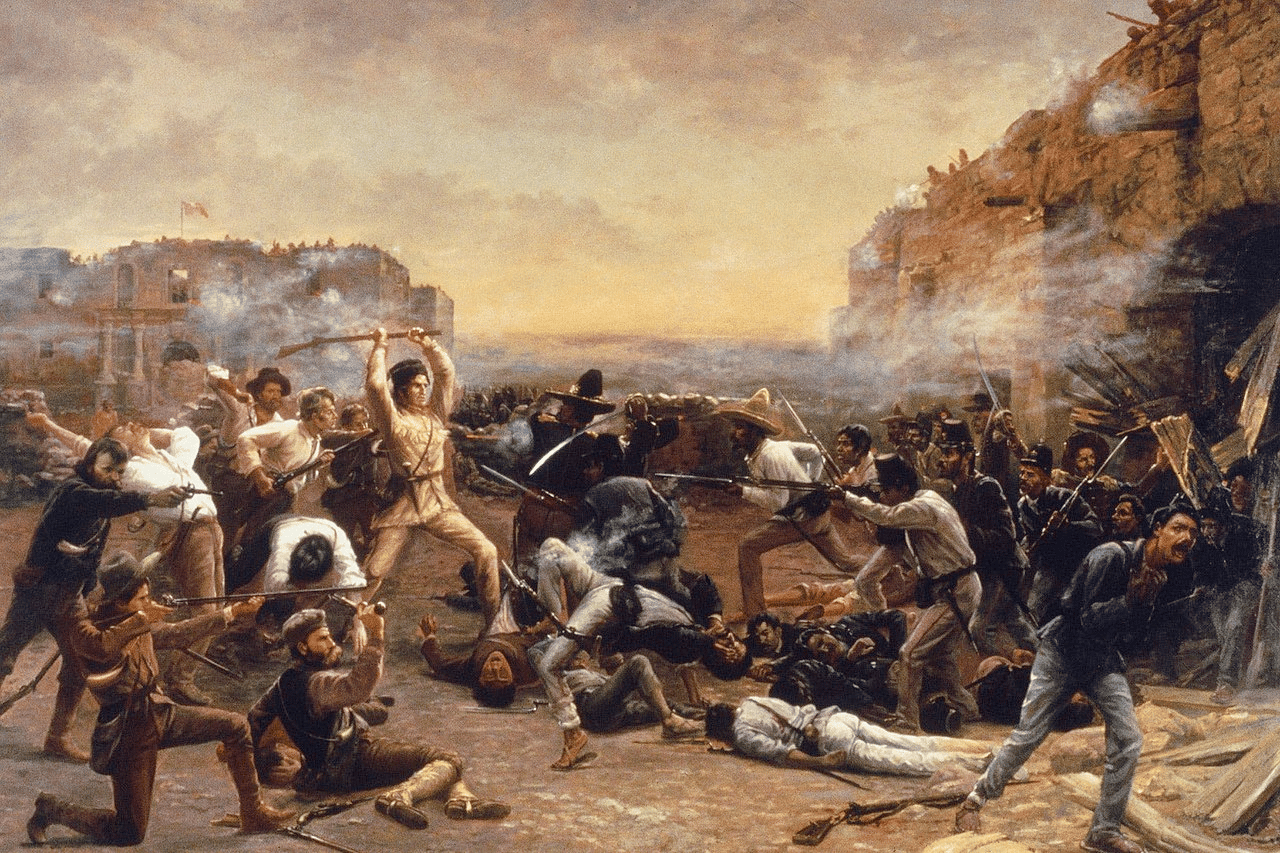
Map Of Texas Landmarks
List Of Texas Landmarks
- The Alamo
- NASA Space Center Houston
- San Jacinto Battleground State Historic Site
- Lyndon B. Johnson National Historical Park
- Southfork Ranch
- San Antonio Missions National Historical Park
- Palo Alto Battlefield National Historical Park
- Waco Mammoth National Monument
- John F. Kennedy Memorial Plaza and The Grassy Knoll
- Fort Davis National Historic Site
- Perot Museum of Nature and Science
- Historic Fredericksburg
- Camino Real de Tierra Adentro National Historic Trail
- Alibates Flint Quarries National Monument
- AT&T Stadium
- Dealey Plaza Historic District
- San Antonio River Walk
- Washington-on-the-Brazos State Historic Site In Texas
- Deep Ellum Historic District
- Pioneer Village
- Reunion Tower
- Cadillac Ranch
- Fort Worth Stockyards
- Galveston East End Historic District
- Port Isabel Lighthouse
Why Trust Us About Texas Landmarks?
We’re Jim Pattiz and Will Pattiz, collectively known as the Pattiz Brothers (and sometimes as the “Parks Brothers”).
You should probably know that we don’t just make this stuff up out of thin air. We absolutely LOVE America’s public lands and have spent our entire adult lives bringing these places to life through our amazing short films.
We’ve worked with the National Park Service, the Department of Interior, USDA, U.S. Forest Service, and more for years creating films on important places and issues. Our work has been featured in leading publications all over the world and even some people outside of our immediate family call us experts on the national parks.
And, in 2018, our father – having spent a lifetime teaching history – joined us so that he could help us to tell the incredible stories behind these amazing places.
Meet The Parks Brothers
We Hope You’ll Join Our Journey

Our goal here at More Than Just Parks is to share the beauty of America’s national parks and public lands through stunning short films in an effort to get Americans and the world to see the true value in land conservation.
We hope you’ll follow our journey through the parks and help us to keep them the incredible places that they are. If you’re interested in joining the adventure then sign up below!
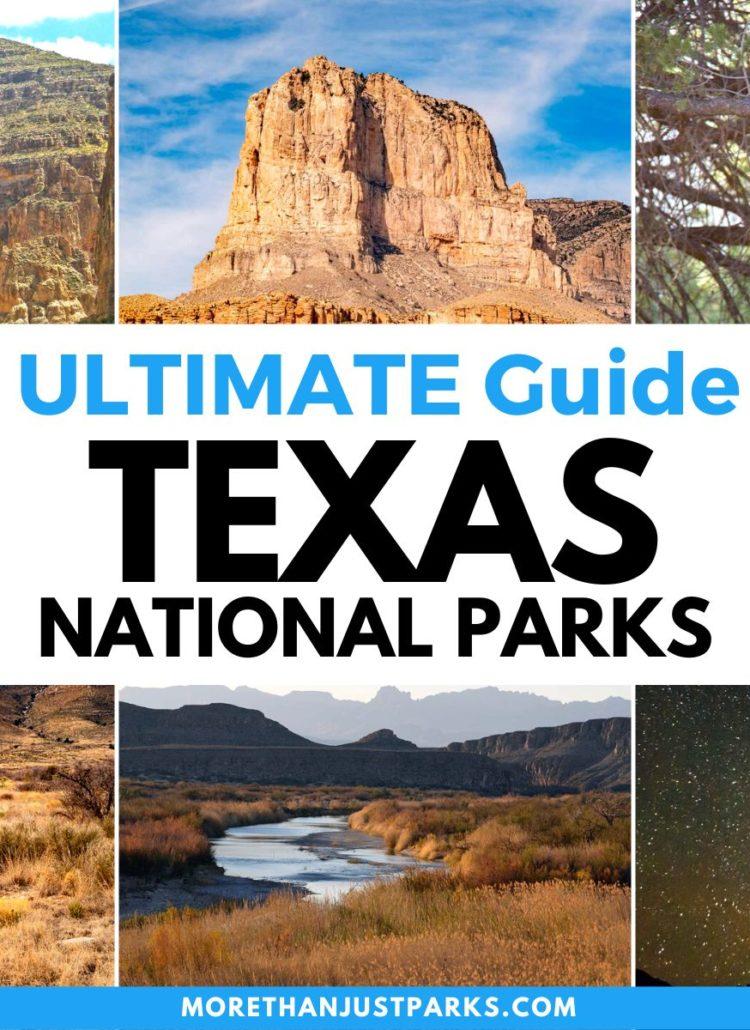
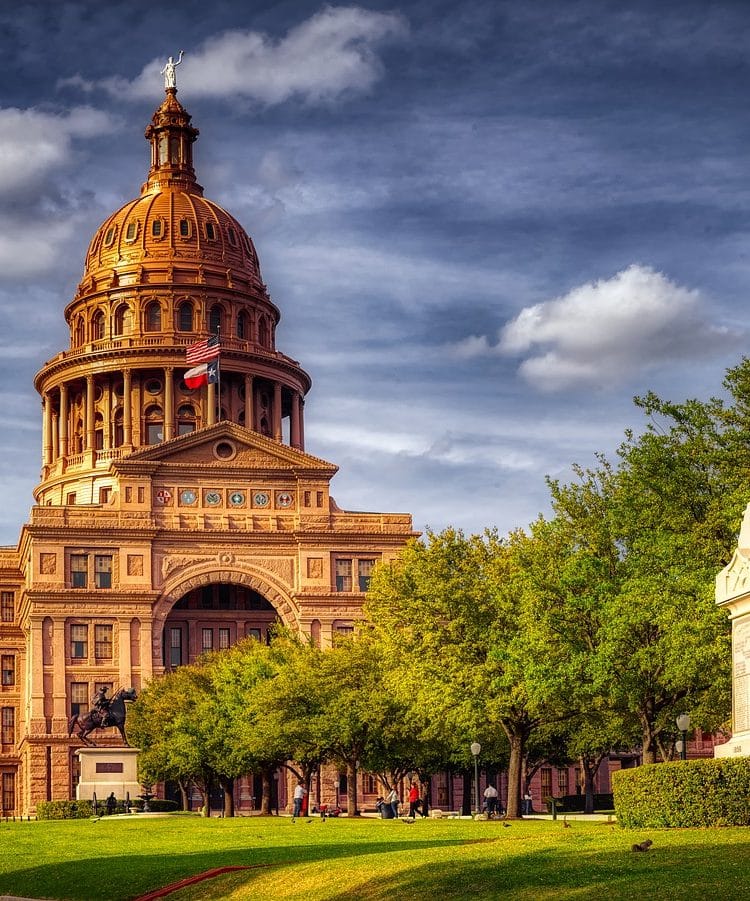
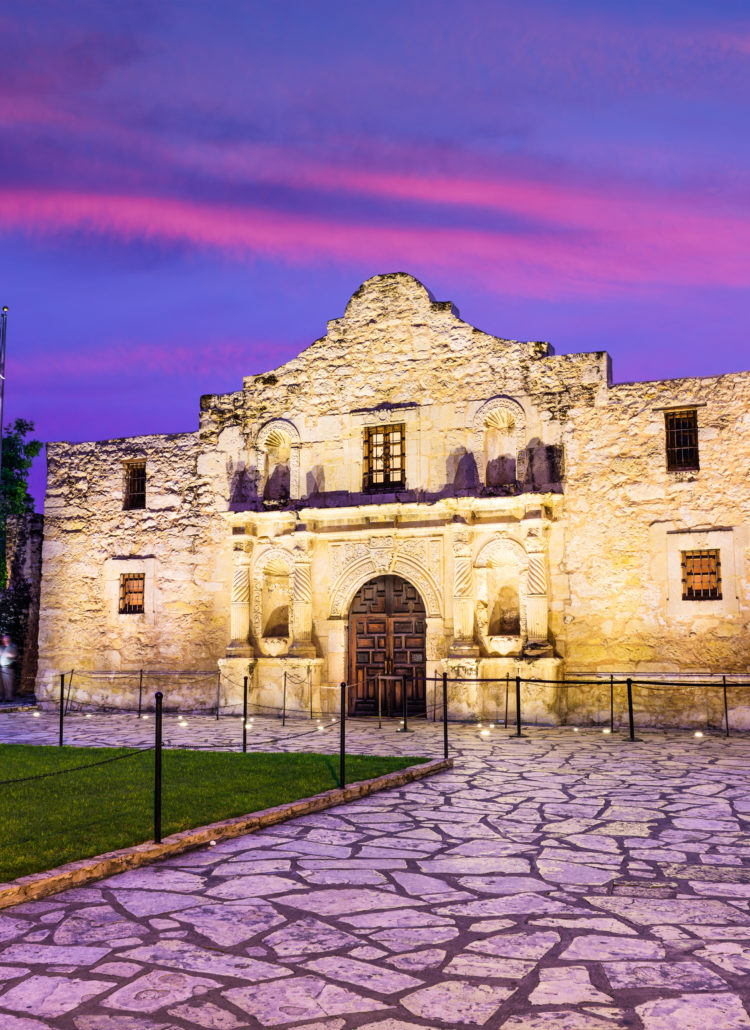
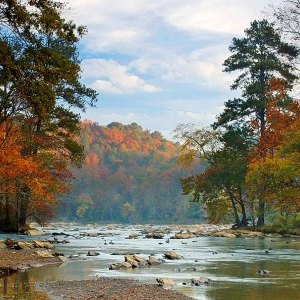

Leave a Reply